
|
|
Reader's Recollections
To facilitate this, I've set up the page which you are now reading to accommodate reader's anecdotes, purely for the reading pleasure of your fellow enthusiasts. We enjoy a great hobby, and these anecdotes do much to remind us of just how great it really is! I've started things off with Wes's contribution, followed by a few personal recollections of my own. I hope that some more of my readers will feel able to contribute as time goes by. A few ground rules - first, the submissions must be true and must tell an engine-related story, preferably with some elements of human interest and/or humour. No fictional accounts or technical dissertations, please! Secondly, they shouldn't be too long. A two or three-page Word document seems to be about right - space won't permit the inclusion of anything longer. Thirdly, relevant images will always be welcome, but they have to be of sufficient quality to allow publication without excessive photoshopping - keeping this website going leaves me with insufficient time for that. The stories already posted will give you some idea of the kind of length and subject matter that I'm looking for. Since this is my own site which is funded entirely out of my own resources, I will exercise my full editorial prerogative in accepting or rejecting a given submission on the basis of the extent to which it meets the foregoing requirements. If a potential rejection will ruin your life, don't submit! I will also reserve the right to edit all submissions which are selected for inclusion - if you aren't willing to submit to editorial oversight, don't submit!! These anecdotes appear here for just one reason - to entertain my readers while reminding them of what a wonderful hobby we all share as well as reaffirming the fact that we're an international community of kindred spirits. I hope that these stories bring back as many happy memories for you as they did for me! I'll begin with Wes Pettinger's contribution that got this page started. ____________________________ My First Engine by Wes Pettinger, Richardson, Texas, USA A while back I happened to run across a video of a 1959 OK Cub .049 running on a test stand. This awakened recollections of the earlier 1949 version which was my first-ever model engine, getting me started 69 years ago (i.e. 1954) on this fantastic engine adventure that shaped my life and future career in engineering and technology.
My friend Howard gave me a well-used DeBolt "Live Wire Kitten" 34 in. wing span cabin R/C model plane with a single channel “Gas-ister” radio receiver, named for the English vacuum tube and germanium transistor used in the design of the radio. He had learned to fly R/C on this plane some years before. Now all that I needed was an engine, a single channel transmitter, batteries and fuel! The next Saturday I rode my bike over to Forster Brothers’ new Corporate headquarters and assembly plant about 4 blocks from my house in Lanark to search for an engine in their “scrap” 55 gallon drum near the back loading dock, into which they tossed all the engines that they received from customers taking advantage of their sales promotion in "Model Airplane News". Customers could get a refund by turning in their used engine when they purchased a new one from Forster.
Bob’s hobby shop supplied the local U-control and R/C guys with most of the goodies needed in the hobby. He suggested a Controlaire “Mule” solid state transmitter that had drawn excellent reviews - a state of the art marvel at the time! He told me that I would have to assemble it, since it was a kit requiring soldering and the ability to identify electronic components. Now I needed an electronic component soldering iron and additional skill sets - just part of this challenge and the anticipated fun. Mom worked for Burgess Battery in Freeport, Illinois about 35 miles away. She was an assembler in their military battery division and kept us supplied with any batteries that we needed, including the small 22½ volt batteries for the receiver’s vacuum tube and the 9 volt battery for transmitter power. And yes, she told me about the Burgess/Morton M5 5-cylinder radial engine that the company store had for sale at a low employee price. Ouch!! Another missed opportunity! The Kitten was loaded down pretty well with all the R/C gear, including the rubber-powered Babcock escapement for the rudder-only control. I suspect that I was exceeding the recommended wing loading here! The system operated on the lines of “Push and hold = right turn, release = self-neutralizing, push twice and hold = left turn”.
I recall the last flight of the Kitten. The wind was gusting, and upon being hand-launched the model did an impressive bounce off the tarmac and was airborne! Everyone cheered, but unfortunately the rest of the flight become free with no radio control. The receiver’s connector plug had come loose AGAIN, probably during the bounce. I knew this right away, as it had happened before. As the Kitten gained a little altitude in free flight mode, wouldn't you know it - for once in its life it got caught in a thermal and flew up, up and away, gaining altitude and heading east over the farmland of Illinois. The host of our flying site fired up his Piper and off we went, tracking the plane until it gracefully landed in a hog pen 15 miles away. Circling overhead, we watched those big sows devour the alien intruder as a shared hors d’oeuvre! I got the engine back about a month later from the kindly farmer, who knew my dad from the Green Giant Company to whom he contracted his fields for peas and corn production. Dad was the plant manager at Green Giant in Lanark, hence being well known in the region. We always included a notification in our planes with a “please return to…..” address. Nice of the hogs to leave enough of that notification for the farmer to read it! Maybe I was wrong on the loose connector. It could have been the end of the 4 hour operating life of the English vacuum tube. I now recall Howard warning me about this……..too late!! Anyway, an interesting introduction to powered model flying! _____________________
A Daunting Challenge - Starting one’s First Diesel! by Adrian Duncan, Coquitlam, BC, Canada Following a family move from my native Australia to England in 1954 when I was seven years old, I started building and flying model aircraft in 1956 when I was nine years old, cutting my teeth on simple gliders and rubber-powered models. But the lure of the then-popular control line format was ever-present, and it was my ambition to become involved in that facet of the hobby as soon as circumstances permitted. The main barrier was financial – I simply couldn’t afford an engine at this stage of my life. At the time in question, the diesel was predominant in Britain for all but a few specialized applications such as control line stunt, speed and Class "B" team racing. So it was more or less inevitable that my first model engine would be a diesel, probably made by a British manufacturer. Accordingly, I read all I could about the care and feeding of model diesels so that when the time came, I would be ready. My favourite book was "Model Aero Engine Encyclopædia"! My well-thumbed second-hand copy eventually fell to pieces when the binding failed through being over-read! In 1959 I was among the oldest of my contemporaries to take the infamous 11-plus examination through which the course of one’s future education (and indeed, one’s overall future to some extent) was then decided. If I had been one month older, I would have taken that exam a year previously! Anyway, I passed the exam and immediately turned 12 years old. My parents were so pleased (or perhaps relieved!) at my 11-plus result (which got me into grammar school) that they decided to really splurge for my 12th birthday and get me something that they knew I was lusting after – a new model diesel engine! The fact that my new school had a thriving aeromodelling society added impetus to my desires, about which I had made no secret!
Anyway, my Dad went to the local hobby shop and bought a brand new E.D. Bee on the somewhat questionable advice (in retrospect) of the shop owner after Dad had told him that the recipient would be a complete beginner with an interest in control line. A FROG 100 or an A-M 10 were both far superior control-line powerplants - I imagine that the shop owner was trying to unload a stock of E.D. Bees and “saw Dad coming”! However, neither Dad nor I knew this at the time. I received this wonderful gift on my birthday with an immeasurable degree of gratitude – I can still remember the feeling! But having the engine was one thing – starting it was quite another! At the outset, I anticipated little trouble – as mentioned earlier, I had read everything that was available on the subject of starting model diesels and considered myself to be very well informed. Alas for over-confidence .............. I made a test mounting block for the Bee and followed the instructions implicitly, even to the extent of using E.D. Standard fuel (which still came in a glass bottle at the time!). Not a crack could I get from the dratted little engine! In retrospect, it’s obvious that I didn’t have the required knack of really “snapping” the prop over by using a combination of arm, wrist and finger. But that’s a knack that comes with practice – I lacked any experience whatsoever at this time. Basically, I had yet to acquire the necessary “feel” for a model diesel engine.
Three hours later, he was still flicking without response apart from the odd pop and a lot of flooding, and I was quite alarmed at the language that was coming out! I learned a lot of new words that evening!
At this point, I was keeping a low profile around the house, feeling that I was somehow the cause of Dad’s increasing frustration and anger. However, it was no longer me pushing him – I’d have been very happy if he’d have given up! But the idea of this pesky little mechanical device beating the great mechanical engineer was a concept with which my rather obsessive Dad simply couldn’t cope. So on he went ..................... At the end of this second evening of torment, Mum had had enough! When Dad emerged from the cellar reeking of ether and with a face like thunder, Mum told both Dad and myself very firmly that the dratted little monstrosity that had assumed such a dominant position in defining the mood of our family had to go and not return until it had ceased to be a source of aggravation and ill-feeling! She Who Must Be Obeyed had spoken ............ Faced with this ultimatum, Dad belatedly remembered that there was a fellow at work who was an active aeromodeller and might be able to help. He hated the idea of having to admit defeat himself, but the imperative by now had become simply to get the thing running by whatever means presented itself. So he packed up the engine with its test block and prop along with the bottle of fuel and took them off to work with him the next morning. What a change that evening!! Dad came rushing in through the door, yelling for the benefit of everyone within hearing “I can do it! I can do it!!” Before anything else was done, Dad insisted upon all of us (even my younger sister) heading down to the cellar where the test stand was once again set up. He filled the tank, choked it, clobbered the prop and away it went! “See?!?” he exclaimed triumphantly, “I can do it every time!” He proved this by repeatedly stopping and re-starting the engine. “It’s all in the flick!!” he proclaimed from the lofty standpoint of his new-found expertise, finally standing aside to let me have another go. Armed with his advice, I quickly had it going myself and have never had any problem starting a diesel from that day to this. It turned out that Dad had taken the engine and stand into the machine shop at his workplace, where his aeromodelling colleague was employed as a machinist. The thing was set up on the bench, the chap set it by “feel” and it started on the second flick, much to Dad’s initial chagrin. A lengthy instruction period followed, However, I think that the incident may have scarred Dad for life! Certainly, he never laid another finger on the prop of a model engine and showed very little subsequent interest in my own consuming passion for the hobby, which has lasted lifelong. Too bad – it would have been nice to do some modelling and flying with him ..................... That was the start of an obsession which remains with me after almost 2/3 of a century and will remain with me lifelong. The Bee went on to serve me well, initially being bolted into a KeilKraft Champ trainer using which I learned to fly control line. A few years later I tuned it to release a greatly enhanced performance closely matching that of the vaunted A-M 10. I feel privileged to have had the opportunity to enjoy such a passionate long-term relationship with my chosen hobby – there’s far too little passion around these days …………! I also count myelf fortunate to have had the chance to experience aeromodelling in the days when it was a far more hands-on and tactile hobby than it is now. Being old has its benefits ...........and it sure beats the alternative! _____________________________
The Heavy Brigade by Adrian Duncan, Coquitlam, BC, Canada If you’ve been flying C/L models for as long as I have, you’ve probably become thoroughly tired of the old “brick on a string” comments that you get from so many of the uninitiated, particularly the R/C crowd! Many people who don’t fly C/L seem to have trouble accepting the fact that C/L models do fly, just like any other flying model, and are not dependent simply on centrifugal force to keep them airborne (like the proverbial brick!). Indeed, if this were not the case, there would be no way that a C/L model could be made aerobatic.
I recall an incident from some years ago which threw this wing loading thing into stark relief! One of the senior members of the Vancouver Gas Model Club to which I belong was a gentleman in his seventies who was a very early and respected member of the Model Aeronautics Association of Canada (MAAC) and was a stalwart supporter of the various events put on by the club. I don’t want to embarrass his memory (he’s deceased now) since he was a valued friend of mine. So let’s call him Jeff (think of me as Mutt!!) - my fellow club members will know about whom I'm speaking! Old Jeff was known for two things – building models that had trouble staggering into the air, and dorking said models into the ground at every opportunity! When this happened (which was frequently), he would never throw the model away – he would repair it and show up next time to try again. His enthusiasm for control-line flying was both unbounded and infectious! Part of Jeff’s trouble was that he never quite got the hang of setting up his engines correctly for the intended purpose. His standard approach to the challenge of getting a heavy model airborne was to try to get more power out of the engine, generally by using an oversized venturi. Of course, this destroyed the engine’s suction, which caused it to sag or cut at the wrong moment, which in turn caused another pile-in........... and so it went! The successive repairs resulted in a progressive increase in the model's weight.
Jeff had a heart of gold, and he knew that I was an engine collector and “fiddler”. He decided on the spot that he’d had enough of this model and gave it to me there and then, saying that at least the engine would be of interest to me! He flatly refused to take any money from me, and that was that. A real gentleman and a great friend ................. I took the model from him and was practically driven into the ground like a nail by the sheer knee-buckling weight of the beast! Its aerodynamic difficulties were well explained on the spot, although no-one taxed old Jeff with this, naturally..................... After Jeff left to head back up to Canada, a few of us stayed at the field to remove the Fox 40. This was soon accomplished, and then we had the problem of what to do with the model. No-one wanted it, and I couldn’t fit it in my little car anyway. So it was agreed that it would simply go into the nearby park rubbish bin to await collection. That was the start of our troubles! The thing was BIG, as I said, and wouldn’t fit into the bin! So it would have to be broken up. Easier said than done!! First, we tried dropping it on the pavement – no effect. Then we threw it at a nearby stone wall with increasing vigor – ditto. We tried to get the wings off by putting it over a knee and pushing on each side – the wings just bent in the middle. Finally, in desperation, we placed it wingtip to wingtip on an angle at the base of the wall and one of the lads took a run at it and landed with both feet square in the middle. The first attempt merely bent it some more, so we flipped it and he tried again. This time, success!! The wing broke in two. A similar process removed the other wing, and we were in business. But what an eye-opener!! It turned out that whenever the thing broke during its former hard life as a working model, Jeff had taken steps to reinforce it! All of the spars were strengthened with lashed-on metal channels, and the broken ribs had been replaced with plywood items. Any gaping holes were plugged by the simple expedient of pouring liquid epoxy into them! The two halves of the wing were quite literally held together by a lump of reinforced concrete - Jeff had inserted twisted piano wires through the joints to act as rebars and had then poured some kind of very hard aggregated concrete or plaster around the rebar! This occupied most of the wing cells closest to the fuselage (although he did include conduits for the leadout wires in the inboard wing). The wing itself was covered with what appeared to be some kind of heavily-doped artist’s canvas! The result was a model having a wing area of some 650 square inches and weighing around 80 ounces (determined by weighing the remains plus the engine as best we could using our field scales). The reinforced concrete accounted for a fair bit of this. The resulting wing loading of over 12 ounces per 100 square inches was enough to doom the model from the outset as an aerobatic performer! It’s a credit to the Fox 40 (a treasured memento which I still have) that it got into the air at all! I took the lessons learned from this incident very much to heart, and have always been very mindful of the weight factor in my subsequent building activities. These "bricks on a string" do fly – but you have to give them a fair chance to do so!! ____________________________
Time to Hang it Up?!? by Adrian Duncan, Coquitlam, BC, Canada In my previous contribution to this page, I introduced an old and dear friend (now deceased) whom we’ll continue to call Jeff out of respect for the memory of a fine gentleman, good friend and dedicated fellow modeller. One could go on forever with Jeff stories, since he was one of those memorable characters who write the script as they go along and never repeat themselves! Here’s another true tale from the twilight years of Jeff’s long and distinguished career as a control-line competitor.
It must be said that Jeff’s ongoing presence certainly added some new and exciting elements to the challenge involved in competing in those events which he entered, especially the racing events! Firstly, he lost his ability to react sufficiently quickly to his own model’s behaviour, with a consequent dramatic increase in the carnage rate of said models. When this happened, he rarely built a new model - he repaired the old one, often with dire results in terms of weight (see “The Heavy Brigade” above)! To compensate, he would tinker with his engines to try to extract more power, generally with the opposite result! As a result, his models became progressively worse performers, adding to Jeff’s challenges. Secondly, Jeff’s vision became progressively less acute and he lost the capacity to anticipate, analyse and respond to interactions between his model and those of others. Avoidance of mid-airs in multi-pilot events therefore became a required survival skill among his competitors, even in dead-level events like sport racing. This challenge was complicated by the fact that Jeff’s flying became increasingly erratic and unpredictable - one had to react like lightning to the unexpected! Each heat was an adventure …………….. Thirdly, Jeff lost the ability to get about in the centre with the required agility to avoid physically interfering with other competitors, who therefore had to do all the avoiding while at the same time trying to remain focused on their own flying. And finally, he got to the point where he was simply unable to keep up with a model that was performing as it should. Despite all of this, Jeff was so enthusiastic and well-liked that no-one had the heart to tell him that he was no longer up to it and that his entry would not be accepted.
In my book, Clown is a drag - the model is based on the old classic 1948 PDQ Products "Flying Clown" aerobatic design but is fitted with a modern high-performance glow-plug motor of up to .199 cuin. displacement drawing fuel from a 1 oz. tank either by suction or pressure. Seemingly a contradiction in terms ……….. The format is simple - you fly three-in-the-circle for 15 minutes exactly, with the one who covers the most laps in that time being the winner. For me, pretty boring stuff, but the fact that there were only a maximum of two other fliers in the centre was a bonus given Jeff’s avoidance issues! The downside was that he had to keep it up for all of 15 minutes - quite a challenge for Jeff by this stage!
Due to the breakdown of entries, there was only one other competitor in Jeff’s heat race - this is allowed under the event rules, and perhaps the organizers specifically arranged such a heat for Jeff! So everything seemed favourable for Jeff to have a pretty good run! The signal sounded, and the motor fired right up. Away went the model …….. straight up, right over the top and down!! Pilot confusion ……………..Jeff manage to pull it out (just about!) before it hit the tarmac, but the landing gear was well bent and the prop was busted. Jeff signalled that he wanted to try again, so we worked on the model while the other competitor enjoyed the reprieve granted to him in having the circle to himself! We quickly sorted the landing gear (more or less) and replaced the prop. Once again, the engine fired right away and we sent it off with a good needle setting. This time Jeff managed to stay out of wingovers and the like. Those Piccos were darn good little engines, and his model quickly settled down and began to look very competitive, actually going faster than the other model in the heat! But therein lay the foundation of the next issue - Jeff couldn’t keep up! The model steadily got further and further ahead of him as he tried to run around the centre area. Plus his model was overtaking his opponent………………… Naturally there could only be one result, and it came soon enough - Jeff’s lines started to wrap around his somewhat taller fellow pilot. Not surprisingly, that worthy found himself greatly inconvenienced by this, and tried ducking and weaving to get out of the tangle, almost being bowled over by Jeff in the process, quite apart from nearly crashing his own model. The inevitable end came when a bob or a weave caused a sufficient disruption to Jeff’s controls that his model pancaked quite neatly, restoring tranquillity to the centre of the circle as the competing flier extracted himself from the wrap and was once again on his own! We had watched all of this with growing incredulity, and fully expected Jeff to call it quits at this point. But not Jeff!! He frantically signalled to us that he still wanted to go back up for more! AAARRRGGGHHH!!!#@?! Ignoring the dagger-like looks from the opposing pit crew (who understandably wanted us to stay down), we sorted the landing gear (again!), changed the prop (again!) and fired up the Picco (again!). But we had now learned an important lesson - with Jeff, speed was the enemy! So the needle came out quite a way and the model went off in far more subdued fashion than previously. Since Jeff now had the slower model and was more or less able to keep up, his opponent was far better able to stay out of line-wraps and to manage the overtaking situation.
So we played our final card - we practically pulled the needle out of the spraybar and sent the model off so rich that we actually doubted that Jeff would be able to coax it into the air! But here we were treated to a masterly display of one of Jeff’s remaining talents!! For the reasons stated earlier, his models were usually so overweight and so inadequately powered that they were generally very marginal fliers at the best of times. Consequently, there was no-one more adept and experienced than Jeff at coaxing an underpowered and poorly set-up model into the air! Jeff was now in his element - he was able to stroll around the centre (presenting a frequent but easy overtaking mark for his opponent) and enjoy doing what he did best - keeping aloft a model that really had no business being in the air!! We finished the heat like that and were well rewarded by Jeff’s very sincere thanks for our help. We were perhaps even better rewarded by his announcement that he didn’t feel up to giving it another go, and would be scratching from the contest. Reprieved ………. and we were relieved as much for Jeff’s sake as for ours!! My association with Jeff remains one of the warmest memories of the many that I’ve accumulated over my many years in control-line modelling. He was always a true gentleman and a great friend. The fact that he clearly should have gracefully bowed out of the contest scene long before he did is in no way a blot on his memory - far from it! On the contrary, it’s a testament to his unquenchable desire to remain active for as long as possible in the hobby that he loved. Indeed, it’s a measure of just how much he loved the hobby that he found it so hard to recognise when the time had come to lower his sights. That was one of Jeff’s last contests - he seemed to take the lesson of that heat race to heart, and confined himself thereafter to one-in-the-circle flying with his own brand of overweight models of indifferent performance. But he never lost his love of the hobby, and his eventual passing from the scene in 2007 was sincerely regretted by one and all. If he did perhaps give all of us some bad moments in the centre circle by hanging on too long, none of us found it at all hard to forgive him! ___________________________
Jeff Takes to the Water by Adrian Duncan, Coquitlam, BC, Canada I’ve mentioned my old late friend Jeff in several previous contributions to this page. Here’s another true tale of past misfortune that will hopefully add further to Jeff’s legend ……………….
However, all that changed during the early 1990’s when some of the local fliers (including myself) made a determined effort to get British-style vintage diesel combat established here on the Canadian West Coast. Our intention from the outset was to keep it uncomplicated, inexpensive and FUN! Accordingly, the rules were simple - 2.5 cc non-schnuerle iron-and-steel diesel motor, unmodified 8x6 nylon airscrew, only a single ball-race permitted (no Ollies), a model built to a published design that had been in common use at some point prior to 1972, no foamies, structural modifications allowed provided the planform was unchanged. The intent was to keep speeds and costs down to a reasonable level and reduce the carnage rate to manageable proportions. It was hoped that this would encourage more people to participate in what was intended to be a low-key “strictly for fun” event. Initially, this worked out well, and I was encouraged to resume combat activity myself, having a lot of fun in the process. A good few of the “Fast” crowd who had had enough of that high-pressure high-cost branch of the sport also joined in. But their former “Fast” colleagues soon noted their absence and came looking for them. This exposed the event to the age-old problem that whenever you organize a competition, someone will want to win it regardless of what it takes - the important thing is to WIN rather than to have fun!! The “Fast” crowd Inevitably, the event thereafter degenerated from a low-key “fun” class into just another dead serious cut-throat carve-up, with fun and sportsmanship being very conspicuous by their absence and the rules being stretched at times to the breaking point. The testosterone flowed, tempers became frayed, the carnage rate went back right up and scorer abuse became common. Only the winners had any fun - the rest were cannon fodder! I for one didn’t stick around long after this development ……………. I fly control line to have fun! But for a couple of years before the “win at all costs” crowd took over, the event did offer a chance to enjoy some low-key “friendly” matches using models that could take a dork or two (unlike the foamies) and could be comfortably flown by a normal human being having normal reactions, with engines that were inexpensive and very user-friendly. Jeff observed this and decided that he might be able to manage one of these relatively slow and manageable models. Here was another chance for Jeff to relive the glory days of his youth, something that he was always up for!!
Our worst fears were soon realized. Jeff’s model was a real dog, and he couldn’t keep up with even these relatively slow models (and his was slower than most). He’d messed about with the engine as usual, and as a result it didn’t run worth beans. This made it more or less impossible for him to get a cut on his opponent, but it also made it very difficult to get a cut on Jeff because his model was completely unpredictable with its uneven motor run, flying in bursts rather than at a constant speed. It was also way slower than the opposing model, making attacks somewhat fraught due to the very high speed differential coupled with the target model’s erratic behaviour. In addition, Jeff was not at all adept at staying out of his competitor’s way, and inter-pilot collisions were the order of the day, as were line tangles. The only way out of a tangle was to dork it in and then sort it, because Jeff was unable to co-operate with the other pilot to resolve tangles in flight. We somehow got through that first contest more or less unscathed, and no-one had the heart to tell Jeff that he really wasn’t up to it - he was simply too well liked. We agreed that a more consistent motor run would improve matters, and I diplomatically persuaded Jeff to let me take his motor home to get it sorted out. There was a lot to sort, but I eventually got it well set up.
Jeff’s model was a lot more predictable with its improved motor run, but his other problems persisted. He had even more trouble keeping up with his model now that it was considerably faster, and the inevitable result was increased inter-pilot interference in the centre circle. I was Jeff's first victim, surviving my match with him by grabbing a quick early cut and then staying as far away from him as I could!! Several matches and line-tangles later, Jeff was still on his feet and still in the thick of it! But the inevitable finally happened - Jeff zigged when he should have zagged - straight into the path of his opponent’s somewhat faster model. Instant matchwood ......... bits flew everywhere, including a small solid lump that was Jeff’s motor, which was last seen heading at high speed in a graceful arc towards the nearby slough! When the wreckage was collected and assessed, one thing was missing - that pesky motor along with its pod! Everyone agreed that it had gone in the direction of the slough, and a thorough grid search of the bankside vegetation was undertaken. No luck ....... and we didn’t have a metal detector handy. It was agreed that the engine might well have gone into the slough, but that wasn’t certain. And if it had gone into the drink, recovery would be a matter of dumb luck more than anything else. It didn’t look promising, and Jeff looked pretty glum. So we returned to the field and the contest went on ............. until we noticed that Jeff was missing! We immediately thought of the missing motor, and off we all went to the slough. And there he was - Nessie in control-line combat guise! There was old Jeff, up to his waist in water and wearing only his knickers, taking deep breaths and ducking under the surface to scrabble along the bottom for his missing powerplant! He kept losing his footing and going for a full-on bath, but that didn’t deter him in the least! He was going to find that motor or die trying.................. Naturally, we weren’t prepared to contemplate the latter possibility, and we couldn’t stand by and watch poor old Jeff suffering in this way! It was a pretty hot afternoon in any case .............. so off came the shirts and pants, and we all waded in! What a hoot - the entire combat field almost naked all splashing around in the muddy water looking for this little piece of Macclesfield metal that meant so much to our mate Jeff. Wish someone had taken a photo ...... but we were all in the water! Actually, on such a hot day the dip was much appreciated! In the end, I was the lucky finder of the motor - I noticed a small oil sheen at one spot a little farther away than people were searching, and there it was on the bottom right below the oil. It had gone quite a bit further than we had expected. We gave Jeff the good news, and he was really happy. Someone did take a photo of the lot of us beside the slough in our knickers, but sadly I’ve been unable to track down a copy after the passage of some 30 years ...... this was in the pre-digital days. I took the motor home again to dry it out, clean it and check for damage. It seemed just fine - it had obviously stopped by the time it hit the water. I soon had it right back on the top line and returned it to Jeff. Jeff did build another Warlord for the recovered motor, but he only entered one more combat event before deciding (rightly) that he wasn’t up to it any more. Thereafter, he stuck to racing and stunt events, although eventually he had to give up the racing as well (see “Time To Hang It Up” above). But it remained true right to the end to say that Jeff was always among the most welcome sights at any control-line contest in our area. Without "characters" like Jeff, this would be a boring old world! Thanks for the memories, mate!! ___________________________ "Fir-Kinell" - Nostalgia Highlights By Ken Croft, Somerset, England
That experience was my very first encounter with aeromodelling and model engines. It was responsible for the hobby that has been with me for almost seventy years and it will be one of my two abiding memories of model flying. When the other memorable event happened, I was well familiar with the vernacular, and the expression was delivered in unison by the assembled multitude, including myself. I have little doubt that the memory will join with the earlier one in accompanying me to my grave.
Today's piped 2.5 cc competition glow motors produce in excess of 3 BHP and the current FAI world control line speed record is over 200 mph on straight fuel with no nitromethane. In 1966 the FAI world speed record for 2.5 cc models on straight fuel stood at a fraction less than 140 mph. Like all sporting records, it had been creeping up each year by only the odd mile per hour. The speed models of the day were tiny. The engines were run up to almost full revs on the ground; they quickly leapt into the air and promptly did the business.
The 1966 FAI world control line championships were held in England at RAF Swinderby in Lincolnshire. As a "professional" speed-watcher, the speed event was my particular interest. The pre-contest grapevine chat had indeed been very interesting. The USA team of Chuck Schuette, Roger Theobald and Bill Wisniewski had been practising "under wraps" on a nearby US airbase for the week prior to the championships, and the buzz was that terrific speeds had been obtained. When Wisniewski came out to fly at the Swinderby event, his model was like nothing seen before. Christened the “Pink Lady” and painted accordingly, it was much larger than the tiny models that were then generally popular for speed flying, and it had an exhaust pipe as long as the model, said to be a "tuned pipe". Such a unit had never before been seen on a model engine in England. A large crowd had gathered in expectation of a very high speed run. The TWA engine was started, but it could barely achieve any decent revs at all. Seemingly in desperation, the model was released on its dolly with the engine rough and blowing lots of smoke. It could hardly pull itself round on the ground, let alone fly. After several laps on the ground, again apparently in desperation and seeking to avoid becoming a laughing stock after such high expectations, the hapless Wisniewski yanked the model round a bit faster and dragged it into the air. It barely flew at all, but staggered around the circle nose high and blowing smoke.
Then it happened. Wisniewski whipped the model up to a certain critical speed, the pipe came on song and the motor produced a noise like we had never heard in our lives. The speed was unbelievable. "Fir-Kinnel!" was the almost audible expression of disbelief uttered under the collective breath of the crowd. Some slight idea of what we experienced may be seen in this video. When the watches had been compared and the speeds computed from the charts, in that one flight Wisniewski had raised the FAI world speed record by 20 mph to just under 160 mph! In athletic terms that was the equivalent of raising the world high jump record by one foot or knocking thirty seconds off a four-minute mile!! And how did Wisniewski celebrate his win? By gleefully taking the trophy home and keeping his winning secrets to himself? Not a bit of it! He gathered all those interested and held a small symposium detailing his tuned pipe and engine developments, handing out full design details to all who attended. Sportsmanship at its very finest. Different days indeed......... For me, nostalgia is not about puttering petrol models, even though I enjoy them immensely. It's about Kenny Baines and his E.D. Bee, and the great Bill Wisniewski unveiling his piped Pink Lady. Those really were the days! _________________________________ Defending the D-C Bantam By Allan Brown, England
Back in 1961 I was about to purchase my first engine. I had saved around £2 and knew what I wanted - a Wenmac Hustler .049, which was then being sold in England at a bargain price of only £1 10s (£1.50). That purchase would leave me with 10 shillings (£0.50) to buy a Mercury Magna kit to go with it. At this time my mentor and tutor in all things aeromodelling was my cousin Bill. He flew big glow-powered free flight models - Ramrods and Creeps - and had just bought a K&B 35 Series 61 to go into a Ramrod 750. Bill’s influence on me meant that my first engine had to be a glow-plug unit! I had big aspirations but very little money or skill. My entry into the world of power modelling was all nicely planned out, but quickly ran into a problem - neither of the model shops in Sunderland had a Wenmac in stock! I just had to have an engine on the day, but what? The next best in price was a D-C Bantam, but its then-current price of £1 19s (£1.95) left insufficient change to cover the purchase of a kit that day.
The Bantam did eventually end up powering a Mercury Magna, which it flew well. I subsequently combined a wing and tail from a KeilKraft glider with a high thrust fuselage (all the rage at the time), and that creation also flew OK with the Bantam up front. However, soon after that I started work, which enabled me to buy a Cox TD .049. At that point, the Bantam was set aside and forgotten for many years. A few decades later, the Bantam re-surfaced in my “discarded” stash. Just for old times’ sake, it went back into another Magna. Quite a revelation - if you launched the model at head height, that's about how high it went for the rest of the flight! I wished that I was 15 foot high! Still, not a complete disaster! However, I did subsequently acquire a Wenmac .049, which certainly proved to be a substantially more powerful engine than the Bantam. Even so, it was my experience with the Bantam that triggered my fascination with model aeroplane engines. I suppose that from that beginning everything was an improvement! However, I confess to retaining a certain fondness for the Bantam despite its performance shortcomings. It got me off to a good start! ____________________________
Travails (to say nothing of Travels) of a Taipan Series 67 1.5 Glo By Gordon Beeby, Victoria, Australia
Upon trying to run the engine, it became obvious that the piston fit was very poor and the ball small-end joint was loose. (Editor’s note – these issues were actually not uncommon even in new examples of this engine). Not being confident of my ability to tighten the ball joint, I sent it back to my mate in SA who knew someone who could fix it. After a while it came back again (its 5th trip between SA and Victoria!) with the ball joint tightened but with the message that the piston fit was very poor and compression very low. Of course, I already knew that! Further attempts to run the engine were not very successful. Eventually I discovered that it did not have the head spacer (someone's attempt to increase compression?) and the piston was badly pitted (I could see the pits once the castor buildup was removed). Various spacer thicknesses were tried along with a greatly increased oil content in the fuel and a variety of different prop sizes, but I still couldn't get any reasonable starting and running. (Editor’s note – removal of the spacer was actually a well-known method of improving this engine’s somewhat mediocre performance). With nothing to lose, I decided to try plating the piston. However, I somehow got things wrong - instead of the piston becoming plated, it became corroded! The engine went from very low compression to no compression. Hmmm..............what next?
One last roll of the dice. Since the replacement piston was cast iron, I figured that I might be able to improve the fit by “cherry-bombing” it. I'd never tried this previously, but there was an article in “Aviation Modeller International / Aeromodeller” for January 2003 on cherry-bombing and hand-lapping which made it sound simple.......... Well, cherry-bombing the piston (heating it uniformly to red heat and then quenching it in brake fluid) did expand it - too much! It was now so tight that it took hours to lap the piston into the liner, leaving me with hands covered in blisters. It sort-of worked – the engine did now have a better piston seal than when I started, but it still wasn't great. It didn't work out as well as hoped, possibly because it was a cast iron piston in an unhardened steel liner. The lapping probably took more off the liner than the piston, while the piston was probably a little out of round from the cherry-bombing and its previous use. (Editor’s note – sounds as if Gordon followed the highly questionable advice in the referenced article by taking the time-honored but potentially damaging approach of using the cylinder as the piston lap! Far better to make a separate piston lap and lap the cherry-bombed piston both round and to the correct size while out of the cylinder).
Getting the engine running was only its next adventure following its travels - there were more adventures to come! The first model that I built for it was an enlarged 24 in. span all-sheet free-flight M. Ballentyne “Clancy” biplane. Even with the engine slowed down, it was wildly overpowered, but I had many flights before it met its end in a vertical right hand spiral terminal-velocity dive. The long-suffering engine survived this incident, remaining ready for more .......!
Sure enough, after a big windstorm 5 weeks later I returned to find the model in pieces scattered around the base of the tree. However, even after all this abuse, all it needed was new rubber bands to put it back together. The only structural damage was a small piece broken off the tailplane. The Taipan engine had proved itself to be a survivor - it still ran after its time in the great outdoors, and the Ebenezer has since continued to be flown regularly. The engine has lost some more piston seal and compression, but I still have it and it still runs! Would I do it all again on another tired old engine? Not on your Nelly! ___________________________ The Matchless McCoy .098 By Dan Vincent
A particularly happy memory for me is the long-ago summer that I spent flying a Testors “Avro Baby” control line biplane powered by a McCoy .098. The story of how I first encountered this model is an interesting one.
About a half hour later he showed up again with a little light blue biplane strapped to the back of the bike. I immediately recognized the McCoy .098 in the nose, but couldn’t place the model. Dave told me that it was a Testor's "Avro Baby", a kit model dating from 1951, and said that I could borrow and fly it until he asked for The model had a 22 in. wingspan and was built from sheet balsa. The stamped aluminum cabane strut cage, landing gear and cowl made for a perfectly lined-up bipe. The kit was even supplied with a stamped aluminium alloy propeller! It looked great, but I was a little hesitant about flying someone else’s model. However, I finally succumbed to temptation and decided to try it. The McCoy engine fired up enthusiastically and the little bipe jumped into the air. It seemed to be rock solid with a pretty good pull on the lines, so I tried a loop..........no problem, nice and tight. Then I tried some inverted flight and it held its altitude very well. When I landed it to refuel, I looked at the airfoil...sure 'nuf, it was symmetrical, so I tried some figure-8's. Again, the little bipe responded beautifully. That little Avro Baby quickly became a firm favorite and I flew it at least once a week all that summer. The little McCoy performed flawlessly throughout. However, at the end of the summer Dave showed up again on his Matchless and was amazed to see that his model was still in one piece after all that flying! He told me that he was relocating to California, hence having to call in the loan of the model and engine. Somewhat reluctantly, I returned it to him still in one piece and with the wonderful little McCoy .098 still in great working order.
I wasn’t the only control line flier who fell under the spell of the Avro Baby. A while later I got talking to John Brodak and we were discussing older models. When I mentioned the Avro Baby, he told me that he too had one and had loved it! In addition to the Avro Baby kit, I think I now have all versions of the McCoy .098. I also liked the more powerful McCoy .09 Diesel. Servicing tip - an OK Cub .14 cylinder wrench is a perfect fit on the cylinder muff of that model. Happy memories of those McCoy .09 engines and that wonderful little Avro Baby! ________________________
The Model Aircraft Engine by Marcus Tidmarsh
The model aircraft engine, a powerful force, Its heart beats with fire, fueling the dream, With every rotation, it breathes life anew, The propeller spins, slicing the air, Through skies vast and wide, it carries the dream, For in the world of models, it takes center stage, ____________________________
Better Late than Never! By Don Imrie, Scotland This is a true story about the resurrection of a classic free-flight model, all of 47 years after its construction by a very talented builder.
About ten days later I was back in the shop, and Peter carefully opened a large box to reveal a FROG 45 free-flight model complete with coil, condenser, timer, etc., as well as a smaller box which had once contained a FROG 175 spark ignition engine. The FROG 45 had been designed by C. T. Buffery in 1946, being specifically tailored to the then-new FROG 175 motor. As the name suggests, its wingspan was 45 inches. Unfortunately, the engine had gone AWOL and was no longer with the model! However, I suggested to Peter that it might be possible to equip the model with a small two-channel radio with two micro-servos and fly it using a FROG 100 diesel instead of the 175 sparker. I knew that the mounting bolt spacing was the same, and we would not require the coil, condenser or ignition batteries. The weight of the radio gear would thus be nicely offset. It was obvious that weight was going to be an important factor, since a model as small as this simply won’t fly if it is asked to carry too much weight. The plan suggested that if the weight was kept below 23 ounces, it should be OK. Since the model actually weighed only 20 ounces, I thought that I had a fighting chance of getting it into the air. What a responsibility, though – 47 years old and never previously flown! What if …….. never mind, don’t even think about it - just get on with it, Imrie! Remember that FROG stands for “Flies Right Off Ground” – a lot of folks don’t seem to know that!
I then removed the coil/condenser assembly, which was conveniently mounted on a vertical sliding plate. Putting all of the removed items on a scale, I found that they weighed 3.8 ounces. I then weighed the two micro-servos, the receiver and the 150 mAh nicad battery pack with the switch harness that I intended to use, finding that all of these components together only weighed 2.9 ounces. Almost a full ounce saved! I actually managed to mount the servos on the sliding plate which I had remove from the model, thus preserving the model in its original condition to the extent possible. The receiver fitted into the adjacent compartment, right on the c/g, and the nicad pack went neatly into the compartment in front of that. Since I was not planning to use the aluminium cowlings supplied with the kit, this positioned the c/g very nicely. On May 16th, 1997, with most of my East Kilbride clubmates looking somewhat bemused, the old FROG 100 diesel with which I had replaced the missing FROG 175 sparkie was warmed up and sounded fine. After a final check-over (this model was 47 years old, after all!), the engine was re-started on a part-filled tank and the model was released. Taking to the air for the very first time after spending 47 years in the attic, it flew quite slowly by comparison with the other things that I’d then flown recently, going into a gentle right-hand circuit. I was just sliding my thumb onto the rudder trim when the engine stopped. The model went into the gentlest of glides right back onto the strip.
Since it would not affect the weight significantly, the micro 27 mhz receiver was subsequently replaced by a 35 mhz Sanwa Club receiver. Many of my fellow Scots model enthusiasts saw it make several successful flights on the Saturday evening fun-flying session at the Scottish R/C Power Nats held at Fife Airport on June 10th, 1997. It was known that the builder of the venerable old model was the recently-deceased Jim Fyfe of Kirkintilloch. While all this had been going on, Lyn McKenna had been in touch with Mrs. Fyfe, who provided the following information about her late husband. James S. Fyfe was born on May 30th, 1927 in Loch Road in Kintilloch, near Glasgow. He lived there throughout his early life, attending Townhead School. His interest in model aircraft began when he was 12 years old. In 1941 Jim started work with Cameron & Robertson, owners of the Star Foundry in Kintilloch, as a 14 year-old apprentice draughtsman. He later moved to Templeton’s Carpets as an assistant engineer. Jim’s subsequent working life took him to the North Bristol Locomotive Works, then to Henry Wiggin in Thornliebank and later to Hereford with the same company, working as a plant engineer. His final move was to Stewarts & Lloyds at Bellshill, later British Steel Corporation, Clydesdale Works. Jim’s working life was marked by his dedication, conscientiousness and perfectionism in all that he undertook. Jim married his wife Mary in 1953, and the couple had four daughters. His meticulous approach was apparent in the many lovely things that he made for his family, such as desks and stools, doll cots, a blackboard and a beautiful doll’s house complete with working lights – the list is endless! He tried his hand successfully at every kind of DIY activity, always displaying his trademark perfection. Always humble about his achievements, Jim was ever ready to pass his knowledge on to others, and rarely complained about having daughters rather than sons with whom to share his knowledge. He worked slowly and with great attention to detail – he used to say that while people admired what he had made, they never asked how long it had taken! Jim’s unflown FROG 45 model had lain in various attics for 47 years. Its survival and successful latter-day airborne excursions are a testament to the painstaking care that Jim put into the building of it. Sadly, Jim Fyfe died of cancer on October 15th, 1993 at the premature age of 66, never having flown his beautiful FROG 45. He was greatly missed by his family and friends. But his model lives on …………….. ____________________________
Ups and Downs! By David Lloyd, England, 2024
That turned out to be the end of my control line career at eighteen years of age after some 8 or 9 years. Work, young ladies, trying to keep my ancient Lambretta scooter road-worthy, etc., created a lack of time to (ever) build a model aircraft again! But how did it all start? My closest friend was Dave Cooksey. He and I lived in Weybridge, Surrey. There was a great model shop inthe High Street displaying the name Eddie Rogers above the door. He was the source of our KeilKraft rubber-powered kits. I We became hooked on the latter, leading me to purchase plans from “Aeromodeller Plans Service”, from which I built an example with my E.D. Hornet up front. Dave did the same, but put his J.B. Atom in his model (dating this to no earlier than late 1955 - Ed.). Mine looked ghastly, but it did fly for a while. Dave’s looked like a scale model should look, but didn’t fly because we could never start the engine! Dave liked the idea of multi-engined scale models and somehow acquired an E.D. 2.46 Racer (Red top). After I did the same, we were planning to combine our efforts to make a scale C/L model of a twin-engined Miles Gemini. However, that never reached completion, for reasons that I can no longer recall after the passage of 67 years!
We bought a pair of 75-foot Laystrate steel lines to tether the model to the control handle. We tried numerous times to get all four engines running at the same time, initially without much success. Eventually a cold Saturday December morning found us heading off to a remote football ground beside the river Thames at Weybridge. The ground was soggy mud, with a breezy cross-wind. This time we actually got all four of the Racers running, including my cranky Green-top. Dave picked up the handle, and the model started to move on the ground, nose up. At that point, two of the engines died, leaving the other two unable to drag the heavy model through the mud at sufficient speed. Undaunted, we tried again, once more getting all four engines going. This time, it was my turn at the handle. The engines all kept going and the big model made it off the ground! After about ten circuits, the engines began to run out of fuel one after the other. I managed to nurse it safely down onto the ground just as the last engine died. Try again? Yes, of course! With Dave on the handle and all four engines running, it climbed off the ground quite well. Perhaps a bit too well - at an altitude of about twenty feet it caught the cross wind - oh dear, you can guess the rest! We conducted an autopsy on what happened. Obviously, the cross-wind caused the beast to flip wing-up and dive into the ground. We also looked at the area where I had been standing and flying. In line with that cross-wind on the downwind side were several trenches in the mud where I had been pulled along on my heels when the wind had pushed the heavy model away from me. Must have been some cross-wind!
However, in later years my other school-years obsession with Dave – the Spitfire aircraft – took a hold on me once more. I derived a lot of pleasure from my Spitfire research. I have had contact with a lady in Canada with whom I still correspond by email. She’s also a Spitfire nut! Flew in one 2010 a few weeks before I managed to do the same thing. She lives near Vancouver, B.C. in a town whose name is something to do with Salmon Jumping. Could that be Coquitlam? (Editor’s note – could be – the native name Kwikwetlem from which Coquitlam is derived means “small red salmon”. It’s my own hometown!) In later years I was a buyer for an engineering company located near the old E.D. works in West Molesey. We encountered a snag with something we had subcontracted to a precision engineering firm in Surbiton with a superb reputation. The principal of that firm turned out to be Ken Day, who showed us his separate small production workshop for the latter-day E.D. engines! Yet another coincidence? Dave Cooksey? Today (2024) that fellow octogenarian rebuilds and races beautiful MG cars dating from 1927 to around 1935! _____________________________ (Editor's note - in 2025 I was delighted to hear from Dave Gurtcheff, a new reader who had only just discovered this website. Dave had been one of the victims of the infamous Deezil scam and was kind enough to share his recollections. Over to Dave ...........) Deezil Reflections By Dave Gurtcheff, USA, 2025
The only diesel fuel available to us was commercial Drone diesel fuel. I tried that, and the engine would not even pop when primed and cranked. A sympathetic adult neighbor heard about my difficulties and noted that the instructions I received recommended SAE 70 oil and ether. None of the local gas stations had 70 weight oil, but he was aware that he could get it at a motorcycle shop, and he bought me some. Without having a clue as to what I was doing I mixed some of the 70-weight oil with the Drone fuel. I found that by putting an eye dropper of oil in the exhaust opening and priming with the modified Drone fuel, the engine would “pop” and sometimes run out the prime for maybe a one or two second run. There was life on Mars, even if it flickered somewhat dimly ………. My best friend and I both bought a Class A control line trainer called the “Baby Cinch” via mail order. The ads said: “A cinch to build and a cinch to fly”. Wrong on both counts - it had a built-up wing with cap strips on the ribs, etc. Complex for a beginner! My buddy bought a Bantam 19 from his older brother, which his brother converted from spark ignition to glow plug. His brother flew his Bantam-powered Baby Cinch for him and taught him to fly (eventually). My buddy’s brother advised me to cut down the wingspan, noting that the Deezil’s displacement was under .19, the minimum sized engine recommended. However, I never managed to fly mine with the Deezil – it never kept running long or strong enough! My buddy and I both had paper routes that paid us $5.00 a week, so my next engine was an Ohlson 23 front RV, in kit form as I recall. That saved me a few bucks, and I had already had the useful experience of assembling the Deezil. From my Ohlson, I went to a Forster 29 with rear downdraft intake and ringed piston, which was only a fair C/L engine, in my opinion. Finally, I was introduced by older fliers at an out-of-town flying field to the crude-looking sand-cast Fox 35. It introduced us to the “4-2-4” break, continuous loops and inverted flying. Thereafter, I grew up with Ringmasters and Fox 35’s; my most difficult build was a Chief with tadpole ribs and a Fox 35. However, I’ve never forgotten that it was the Deezil, for better or worse, that started all this! My enthusiasm somehow survived the Deezil experience! ______________________________
|
| |
 In June 2023, m
In June 2023, m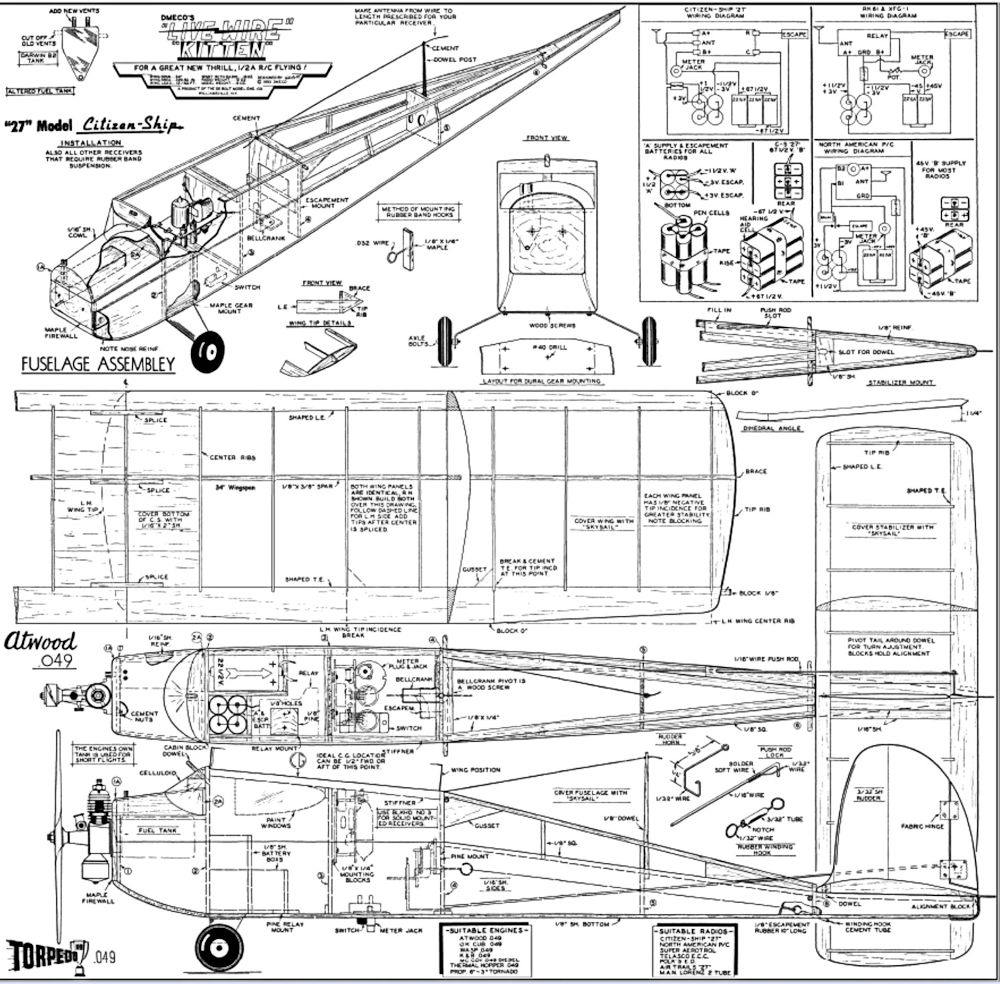

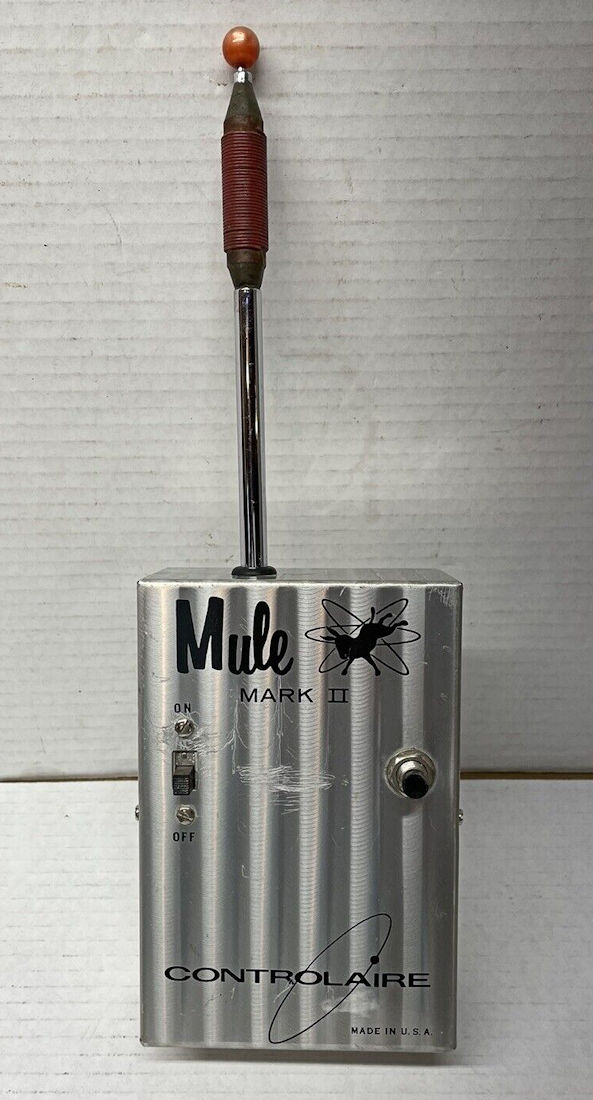 Next, I pedaled 7 blocks down town to Shane’s Shoe and Hobby Shop. You knew right away that Bob, the owner, had a new model airplane under construction from the smell of Ambroid cement and Aero Gloss paint in the air!
Next, I pedaled 7 blocks down town to Shane’s Shoe and Hobby Shop. You knew right away that Bob, the owner, had a new model airplane under construction from the smell of Ambroid cement and Aero Gloss paint in the air! 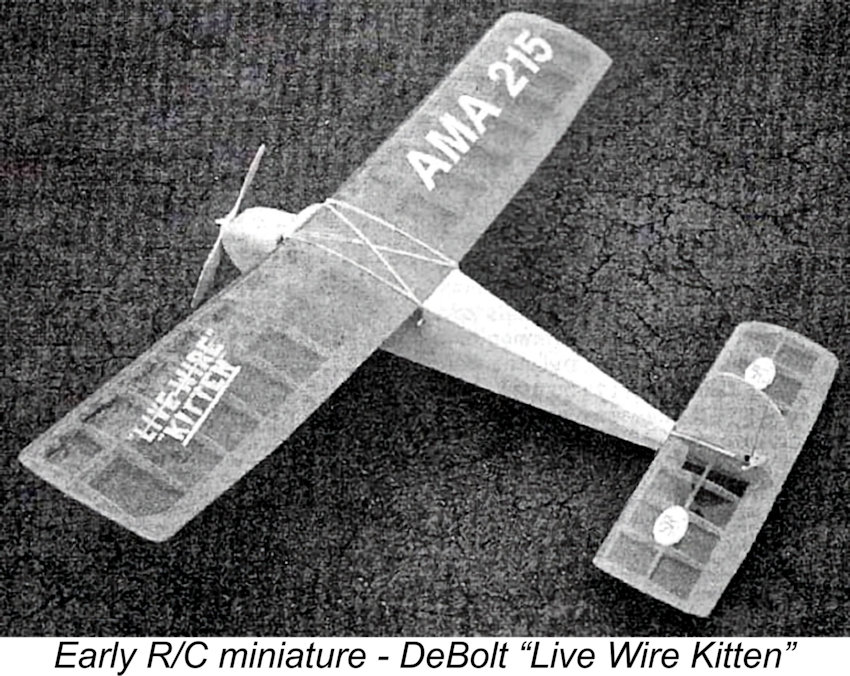 The little OK Cub did everything in its power to get the plane airborne, with a number of successful flights being achieved, each of which was considered a divine blessing. The rather under-powered model had to be flown in zero or light wind and never did manage to climb very high. Out of self-defense, most guys on the field put their truck lids down when I flew and were pleased that I had only a small 2 oz. fuel tank installed!
The little OK Cub did everything in its power to get the plane airborne, with a number of successful flights being achieved, each of which was considered a divine blessing. The rather under-powered model had to be flown in zero or light wind and never did manage to climb very high. Out of self-defense, most guys on the field put their truck lids down when I flew and were pleased that I had only a small 2 oz. fuel tank installed! 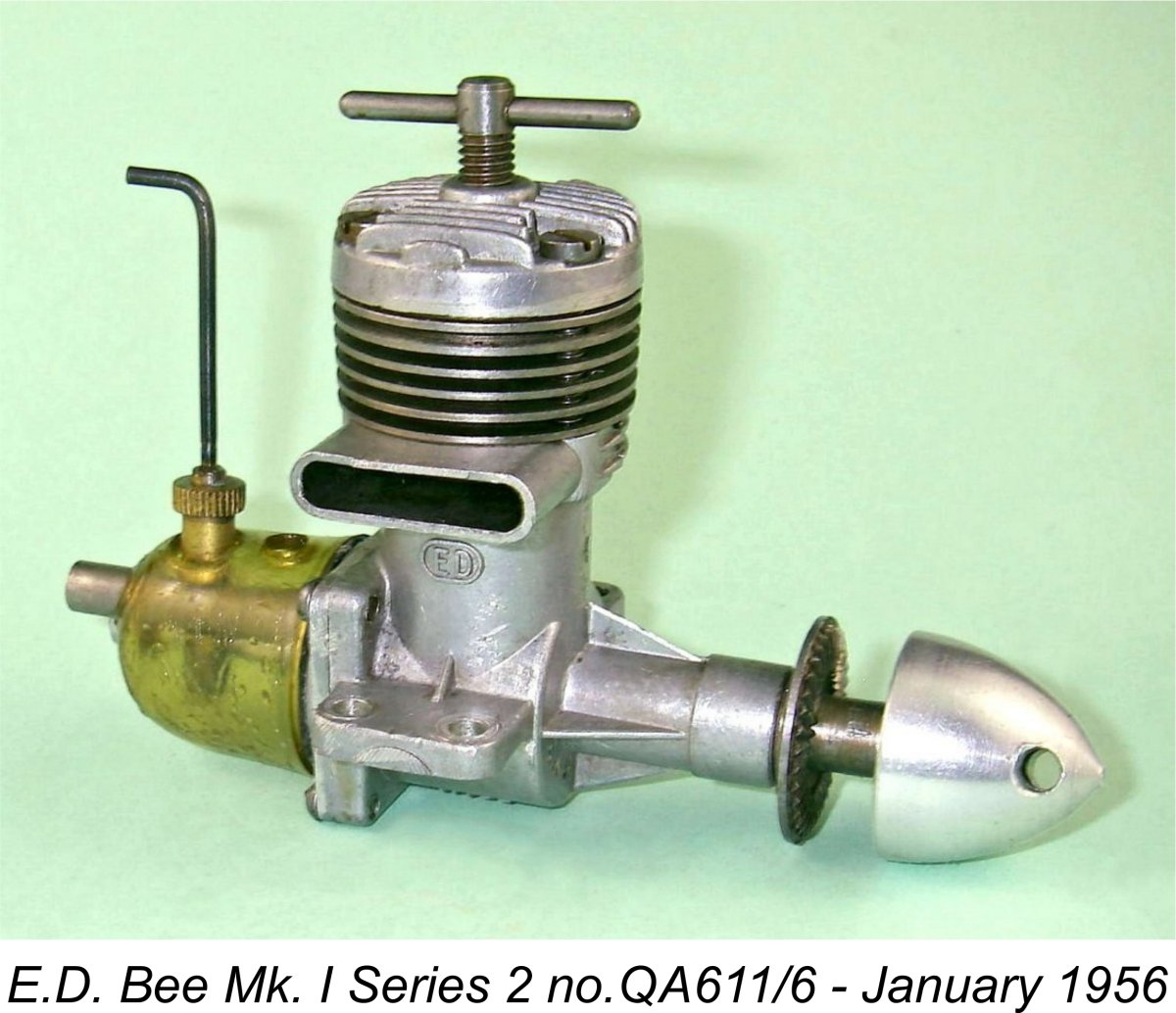 One of the standard beginner’s engines at the time was the 1 cc E.D. Bee diesel, then in its Series 2 form with loop scavenging and glow-motor style side stack exhaust. It was far from being the most powerful 1 cc diesel of its time, and was in fact a bit of a standing joke among serious modellers. This was quite undeserved, since the Bee was an easy-starting and very durable engine which could be relied upon to give long and faithful service as long as one set it up right and didn’t expect contest levels of performance out of the box.
One of the standard beginner’s engines at the time was the 1 cc E.D. Bee diesel, then in its Series 2 form with loop scavenging and glow-motor style side stack exhaust. It was far from being the most powerful 1 cc diesel of its time, and was in fact a bit of a standing joke among serious modellers. This was quite undeserved, since the Bee was an easy-starting and very durable engine which could be relied upon to give long and faithful service as long as one set it up right and didn’t expect contest levels of performance out of the box.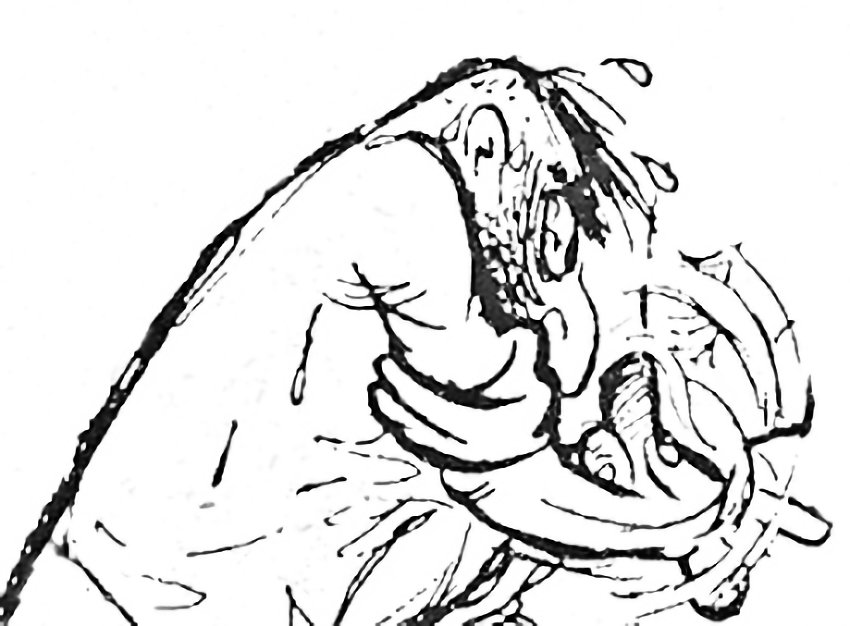
 Dad finally gave up and stomped off to bed with a scowl on his face, a sore right index finger and a headache. But he was not the man to allow anything mechanical to beat him! The next night he was back down again for another three-hour period, with no better result. By now, his bad temper was making itself felt to one and all, even my long-suffering Mum. There was tension in the air ....................
Dad finally gave up and stomped off to bed with a scowl on his face, a sore right index finger and a headache. But he was not the man to allow anything mechanical to beat him! The next night he was back down again for another three-hour period, with no better result. By now, his bad temper was making itself felt to one and all, even my long-suffering Mum. There was tension in the air ....................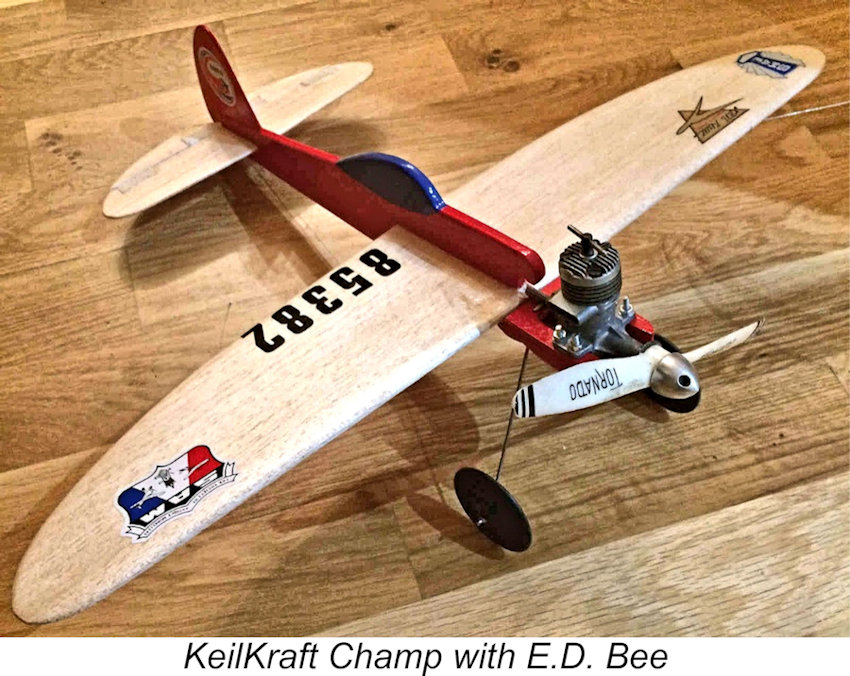 aimed at arming Dad with the necessary snappy flick and "feel" required to start any model diesel engine. This is one of those knacks which can take a little while to acquire but once learned is so easy that you wonder why you ever had any trouble! Dad soon had it down, with the results reported above .............
aimed at arming Dad with the necessary snappy flick and "feel" required to start any model diesel engine. This is one of those knacks which can take a little while to acquire but once learned is so easy that you wonder why you ever had any trouble! Dad soon had it down, with the results reported above ............. 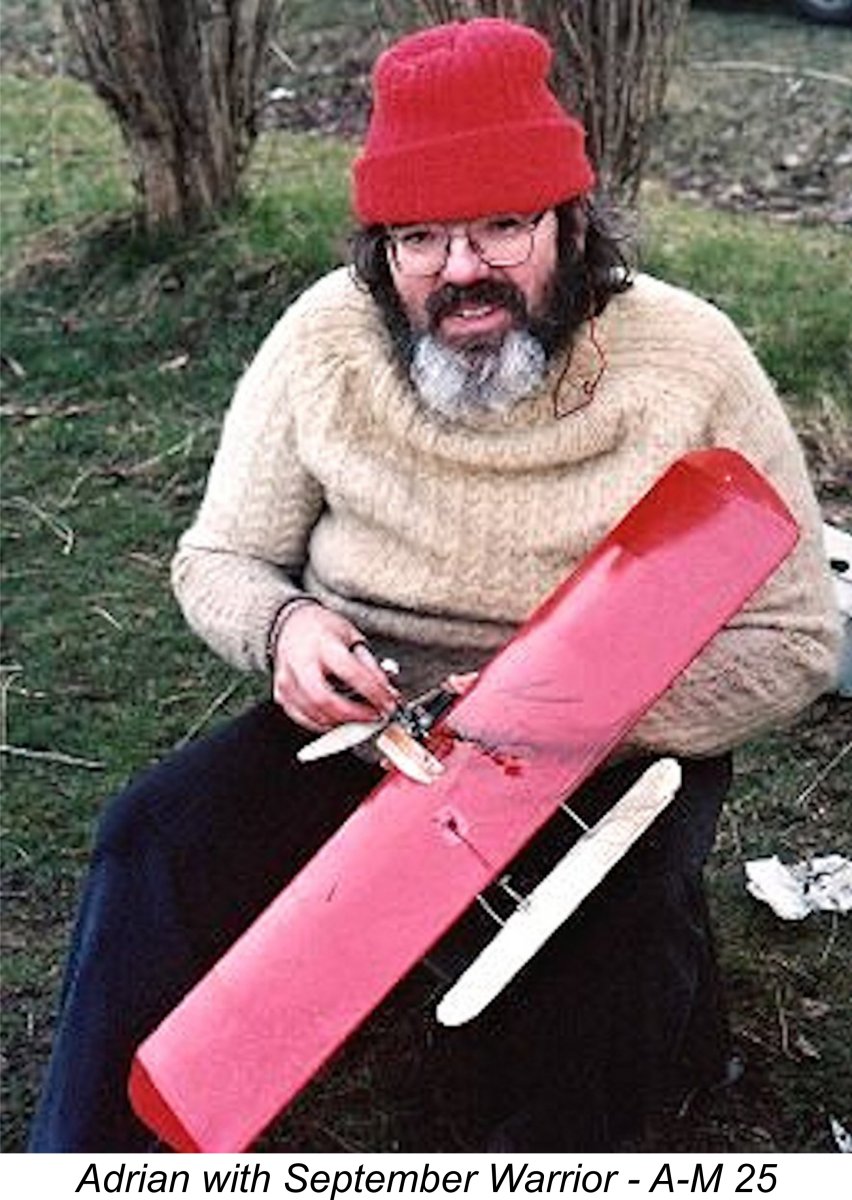 For this reason, the issues of wing loading and aerodynamic design are just as important for a successful C/L model, particularly an aerobatic one, as they are for any other flying model. Speaking personally, I always aimed for a maximum wing loading of 6½ ounces per 100 square inches of effective wing area. This means that with a 240 square inch 2.5 cc vintage diesel combat model (the type that I flew most frequently during the latter stages of my competition career), the weight has to be kept below 16 ounces for a competitive performance. Not hard to do, but it does require careful weight management during the building process. And the results are spectacular – the aerobatic performance of a model built to this loading is way ahead of a similar model weighing only an ounce or two more. With my ½-A (1.5 cc) vintage diesel combat models, it was usually possible to get down to 5½ ounces per 100 square inches, and those models were a joy to fly.
For this reason, the issues of wing loading and aerodynamic design are just as important for a successful C/L model, particularly an aerobatic one, as they are for any other flying model. Speaking personally, I always aimed for a maximum wing loading of 6½ ounces per 100 square inches of effective wing area. This means that with a 240 square inch 2.5 cc vintage diesel combat model (the type that I flew most frequently during the latter stages of my competition career), the weight has to be kept below 16 ounces for a competitive performance. Not hard to do, but it does require careful weight management during the building process. And the results are spectacular – the aerobatic performance of a model built to this loading is way ahead of a similar model weighing only an ounce or two more. With my ½-A (1.5 cc) vintage diesel combat models, it was usually possible to get down to 5½ ounces per 100 square inches, and those models were a joy to fly. 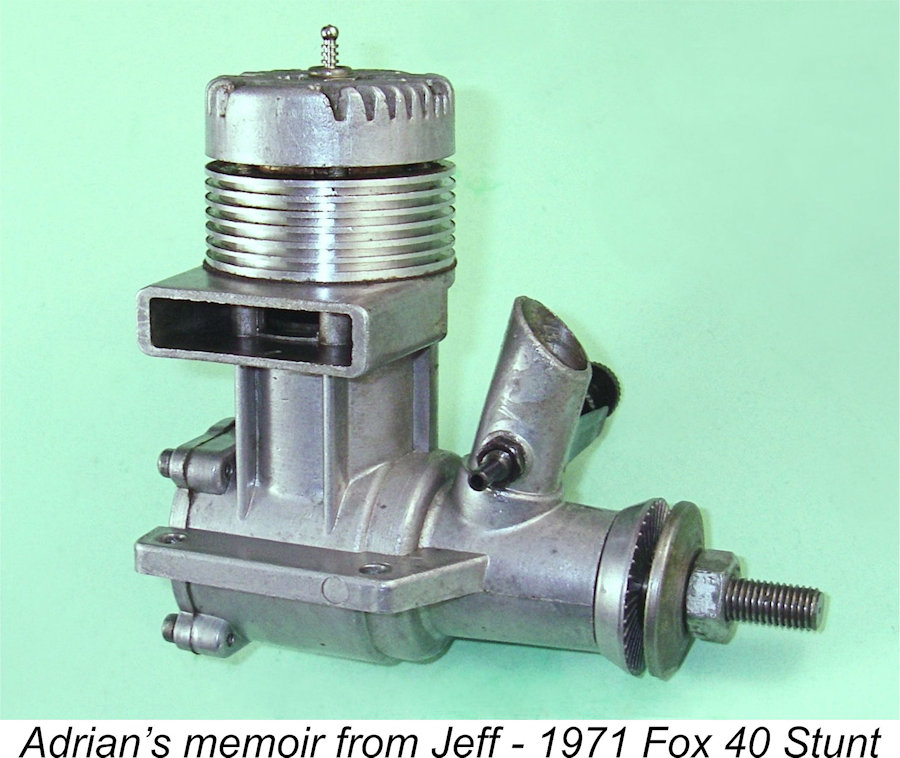 Near the end of Jeff’s career as a model flier, we all went down across the US border to fly in a vintage diesel combat event in a park near Seattle. Jeff came along as always, and he brought a large and clearly very “experienced” stunt ship to play with when the combat bouts were either on hold or completed. It proved that this beast (which was powered by a 1971 Fox 40 Stunt engine) could barely stagger into the air with the engine howling, let alone perform stunts, and the inevitable ending was soon reached with the model returning the hard way to terra firma. The fact that Jeff had removed the engine's intake venturi restrictor, thereby destroying its suction, doubtless contributed to this outcome.
Near the end of Jeff’s career as a model flier, we all went down across the US border to fly in a vintage diesel combat event in a park near Seattle. Jeff came along as always, and he brought a large and clearly very “experienced” stunt ship to play with when the combat bouts were either on hold or completed. It proved that this beast (which was powered by a 1971 Fox 40 Stunt engine) could barely stagger into the air with the engine howling, let alone perform stunts, and the inevitable ending was soon reached with the model returning the hard way to terra firma. The fact that Jeff had removed the engine's intake venturi restrictor, thereby destroying its suction, doubtless contributed to this outcome. 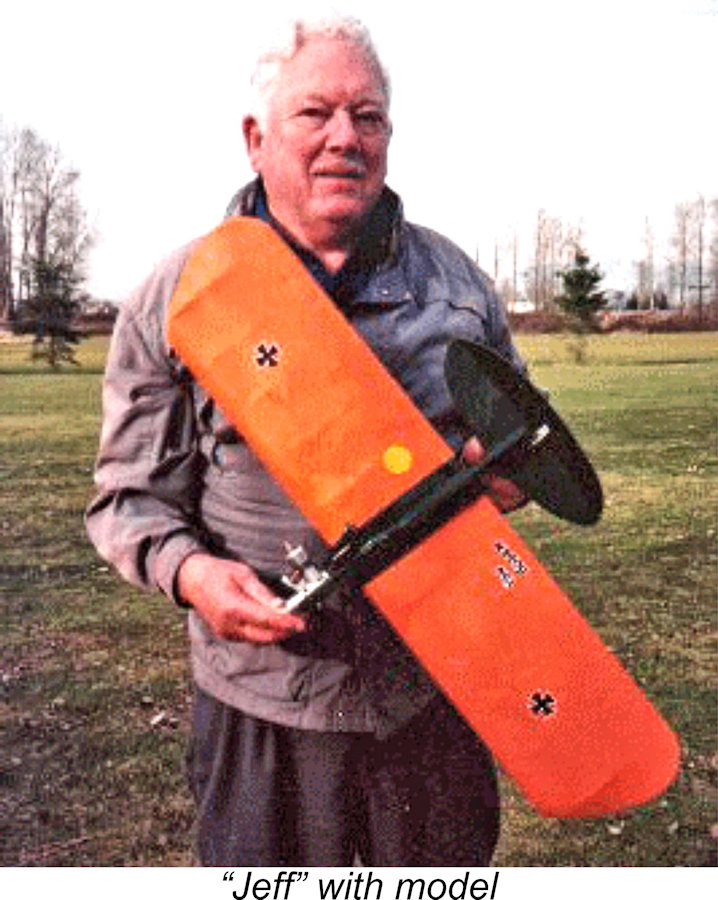 Jeff was a charter member of the Model Aeronautics Association of Canada (MAAC) upon its founding in 1949, and was a respected competitor who had assembled a fine contest record in his heyday. But time moves relentlessly along, and perhaps Jeff’s greatest failing as he grew older was that he simply didn’t know when it was time to quit! It’s a sad fact that as we age our capacities for clear vision, quick thought and quick movement progressively decline, and so it was with Jeff. We can accommodate these changes by setting our sights a little lower and continuing to enjoy our chosen activities at a slightly more relaxed level. But not old Jeff!! Despite his advancing years and diminished capabilities, the competitive juices flowed as strongly as ever, and he remained a fixture at the control-line contests in our area.
Jeff was a charter member of the Model Aeronautics Association of Canada (MAAC) upon its founding in 1949, and was a respected competitor who had assembled a fine contest record in his heyday. But time moves relentlessly along, and perhaps Jeff’s greatest failing as he grew older was that he simply didn’t know when it was time to quit! It’s a sad fact that as we age our capacities for clear vision, quick thought and quick movement progressively decline, and so it was with Jeff. We can accommodate these changes by setting our sights a little lower and continuing to enjoy our chosen activities at a slightly more relaxed level. But not old Jeff!! Despite his advancing years and diminished capabilities, the competitive juices flowed as strongly as ever, and he remained a fixture at the control-line contests in our area. 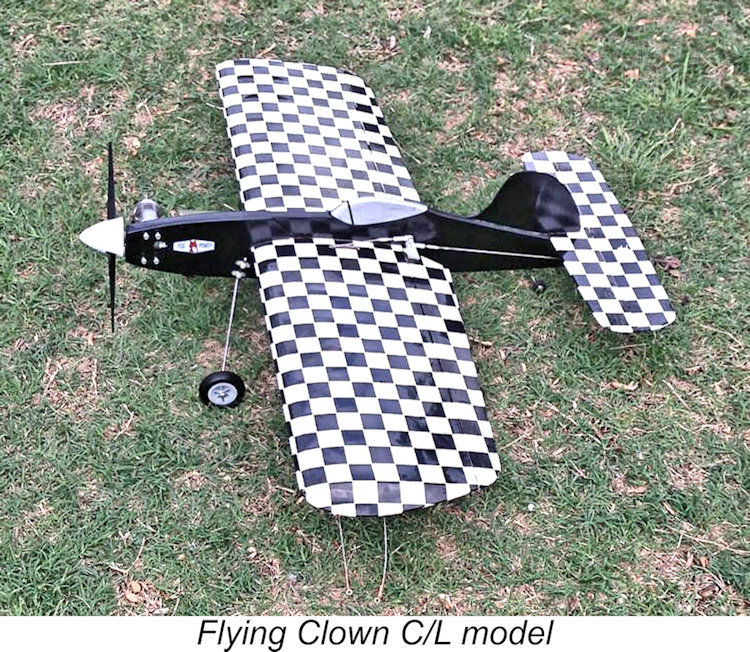 The following true tale will illustrate the problems which all of this caused. At the time in question, I was the pit-man in a highly successful Northwest Sport Race team (profile fuselage, unmodified Fox engine, standard fuel, .15 and .35 classes). My pilot and I showed up for a local contest to find old Jeff wandering around looking for a pit crew for the Flying Clown sport-racing event which he’d entered. Being gluttons for punishment as well as being on the best of terms with Jeff, we took pity on him and agreed to pit his model.
The following true tale will illustrate the problems which all of this caused. At the time in question, I was the pit-man in a highly successful Northwest Sport Race team (profile fuselage, unmodified Fox engine, standard fuel, .15 and .35 classes). My pilot and I showed up for a local contest to find old Jeff wandering around looking for a pit crew for the Flying Clown sport-racing event which he’d entered. Being gluttons for punishment as well as being on the best of terms with Jeff, we took pity on him and agreed to pit his model.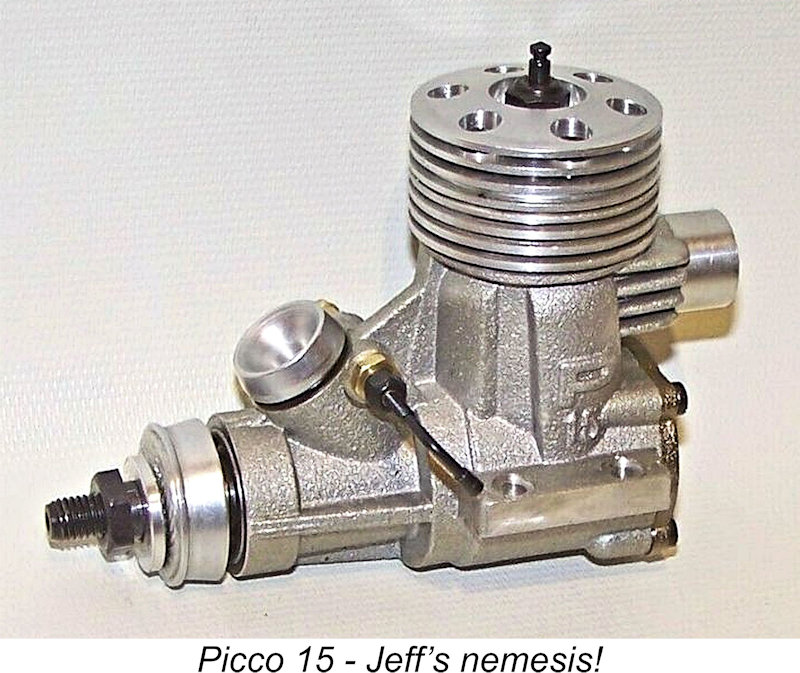 For once, Jeff had a newly-built uncrashed model in good condition, with a near-new Picco .15 up front. We checked it over and it looked fine - everything was well attached and the controls seemed to work perfectly. The pull test and the engine test-run both went well, and we actually thought that Jeff might make a reasonable showing for once……………….
For once, Jeff had a newly-built uncrashed model in good condition, with a near-new Picco .15 up front. We checked it over and it looked fine - everything was well attached and the controls seemed to work perfectly. The pull test and the engine test-run both went well, and we actually thought that Jeff might make a reasonable showing for once………………. 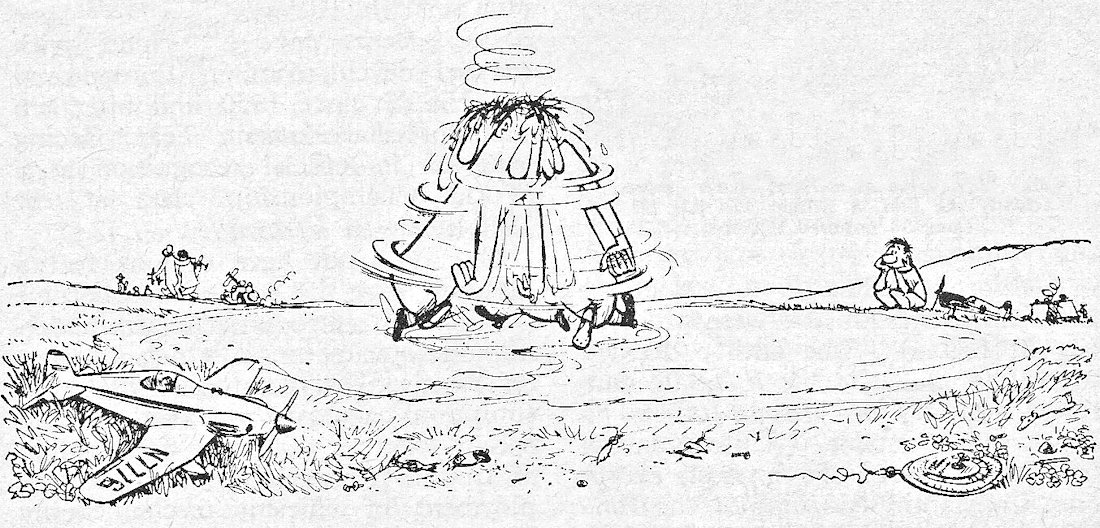 We thought at this point that we had it cracked, but there was still more to come ………… At the first pit stop after the second crash, we were a bit concerned to notice that Jeff was looking a little blown in the centre while he waited for us to get him up again. Partway through the next stint it became apparent that there was reason to worry - Jeff was clearly in physical distress, even at the reduced speed that we’d given him. By the end of that stint he was really beginning to stagger and was once again beginning to make physical contact with his opponent due to his loss of control over his own mobility. But he still indicated that he wanted to continue - his fighting spirit simply wouldn’t let him quit! What a competitor!!
We thought at this point that we had it cracked, but there was still more to come ………… At the first pit stop after the second crash, we were a bit concerned to notice that Jeff was looking a little blown in the centre while he waited for us to get him up again. Partway through the next stint it became apparent that there was reason to worry - Jeff was clearly in physical distress, even at the reduced speed that we’d given him. By the end of that stint he was really beginning to stagger and was once again beginning to make physical contact with his opponent due to his loss of control over his own mobility. But he still indicated that he wanted to continue - his fighting spirit simply wouldn’t let him quit! What a competitor!! 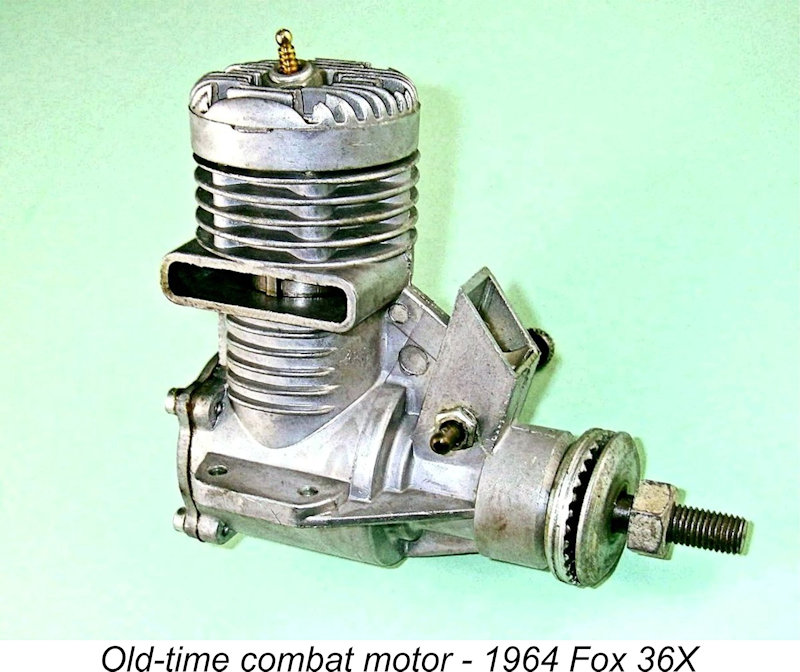 One of Jeff’s favourite events was control line combat. In his younger days during the 1950’s and 1960’s, he had been quite adept at this challenging sport, earning his share of wins in the good old days of North American “Fast Combat” using the old-style .36 cuin. loop-scavenged glow-plug motors. But time marches on, and by the mid 1980’s Jeff had abandoned this branch of the hobby for more relaxing events which remained within his capabilities.
One of Jeff’s favourite events was control line combat. In his younger days during the 1950’s and 1960’s, he had been quite adept at this challenging sport, earning his share of wins in the good old days of North American “Fast Combat” using the old-style .36 cuin. loop-scavenged glow-plug motors. But time marches on, and by the mid 1980’s Jeff had abandoned this branch of the hobby for more relaxing events which remained within his capabilities. 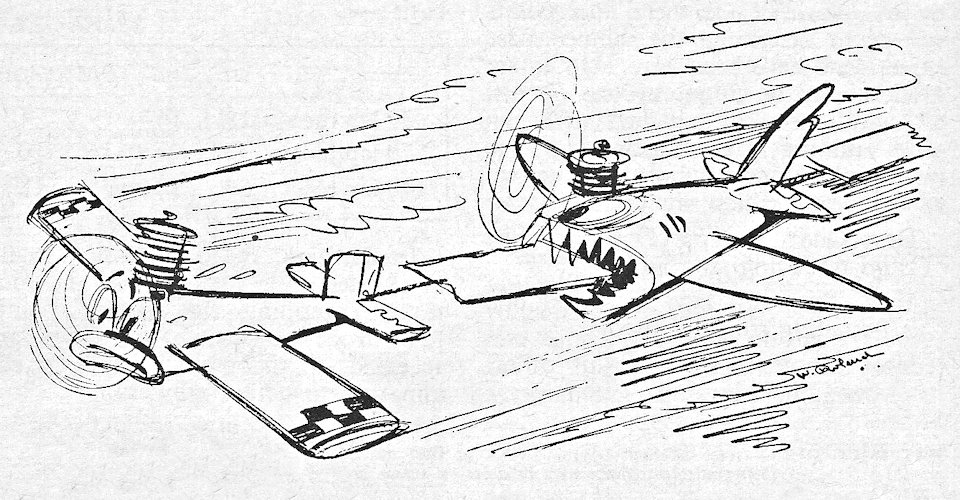
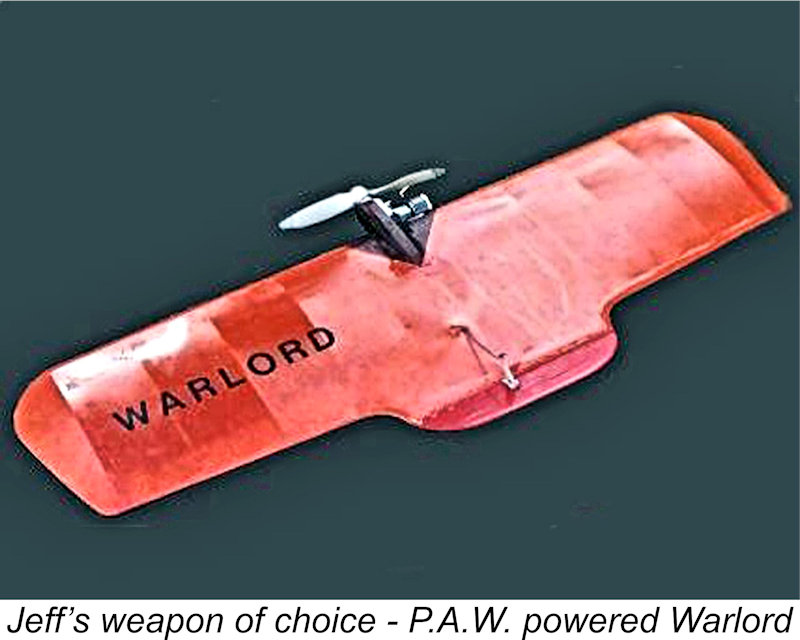 Everyone had strong misgivings when Jeff showed up for his first event with a “new” Warlord that he’d cobbled together. It had a P.A.W. 249 BR up front (the motor of choice for this event) and weighed in at a hefty 19 ounces (mine weighed less than 16 ounces with the same engine!). Building light wasn’t Jeff’s strong suit (see “The Heavy Brigade” above)!
Everyone had strong misgivings when Jeff showed up for his first event with a “new” Warlord that he’d cobbled together. It had a P.A.W. 249 BR up front (the motor of choice for this event) and weighed in at a hefty 19 ounces (mine weighed less than 16 ounces with the same engine!). Building light wasn’t Jeff’s strong suit (see “The Heavy Brigade” above)! 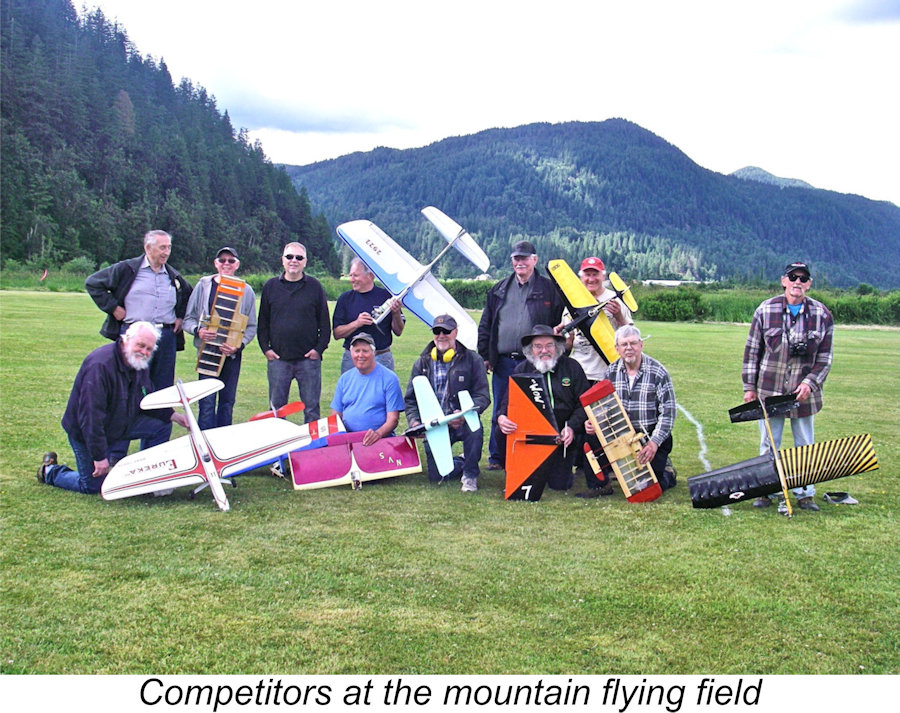
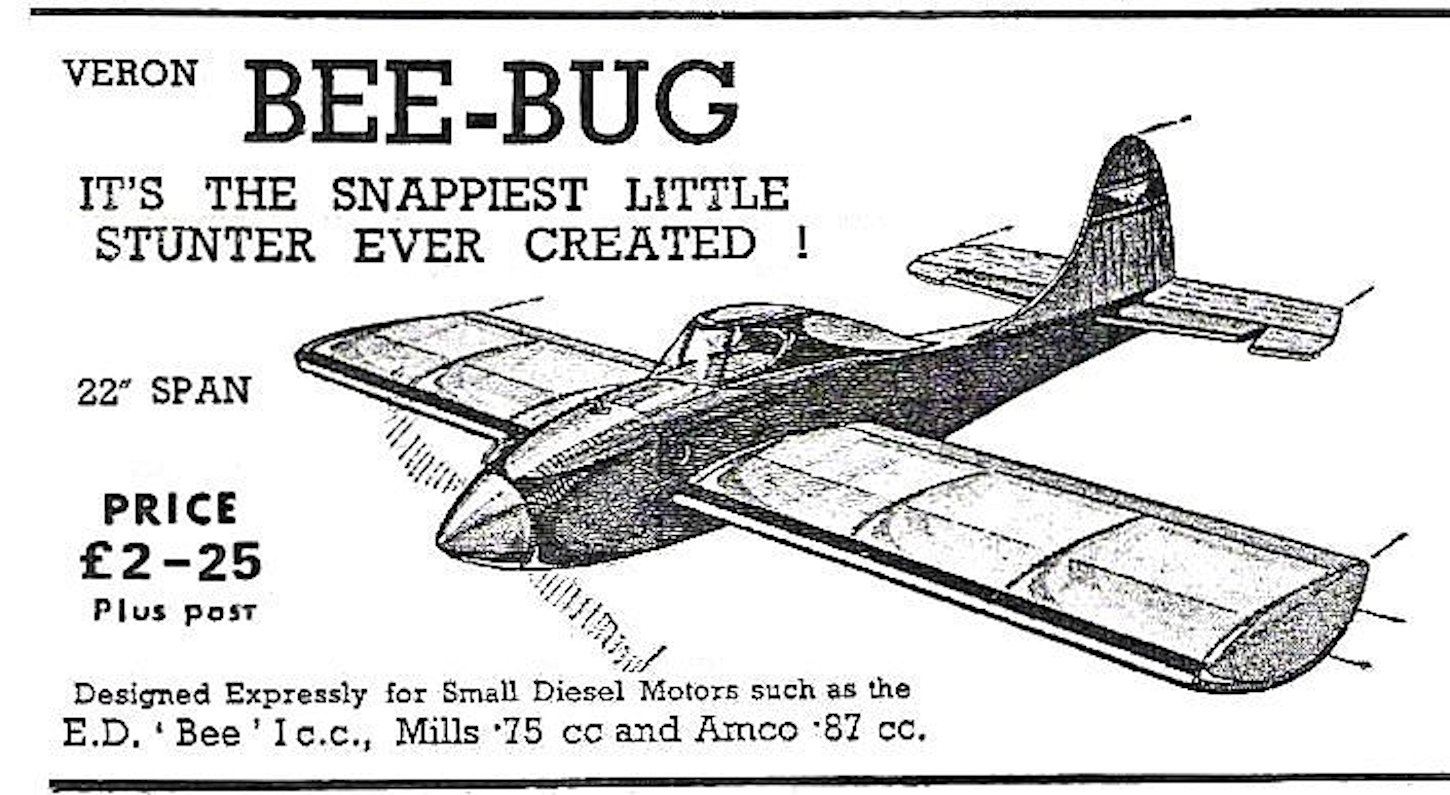 Had I known such an expression of surprise at the tender age of ten or twelve years, the sound and sight of Kenny Baines and his big brother flying an
Had I known such an expression of surprise at the tender age of ten or twelve years, the sound and sight of Kenny Baines and his big brother flying an  This piece is really about the second event, but to appreciate the situation you must cast your mind or your imagination back to the time prior to 1966. Model engines were not as developed as they are today. The 0.36 BHP works-tuned Oliver Tiger was probably still the most powerful commercial 2.5 cc diesel, while certain 2.5 cc competition glow-plug motors were then reaching towards the 0.50 BHP range. In unrestricted competitions, glow engines ran on as much nitromethane as you could afford to burn, although by that time FAI rules required the use of straight fuel in International competitions under their jurisdiction. Silencers were increasingly appearing on British flying fields, but tuned pipes had never yet been seen on model engines in England at the time. Kevin Lindsey had been quietly conducting experiments in England beginning in late 1965, but his efforts remained below the radar.
This piece is really about the second event, but to appreciate the situation you must cast your mind or your imagination back to the time prior to 1966. Model engines were not as developed as they are today. The 0.36 BHP works-tuned Oliver Tiger was probably still the most powerful commercial 2.5 cc diesel, while certain 2.5 cc competition glow-plug motors were then reaching towards the 0.50 BHP range. In unrestricted competitions, glow engines ran on as much nitromethane as you could afford to burn, although by that time FAI rules required the use of straight fuel in International competitions under their jurisdiction. Silencers were increasingly appearing on British flying fields, but tuned pipes had never yet been seen on model engines in England at the time. Kevin Lindsey had been quietly conducting experiments in England beginning in late 1965, but his efforts remained below the radar.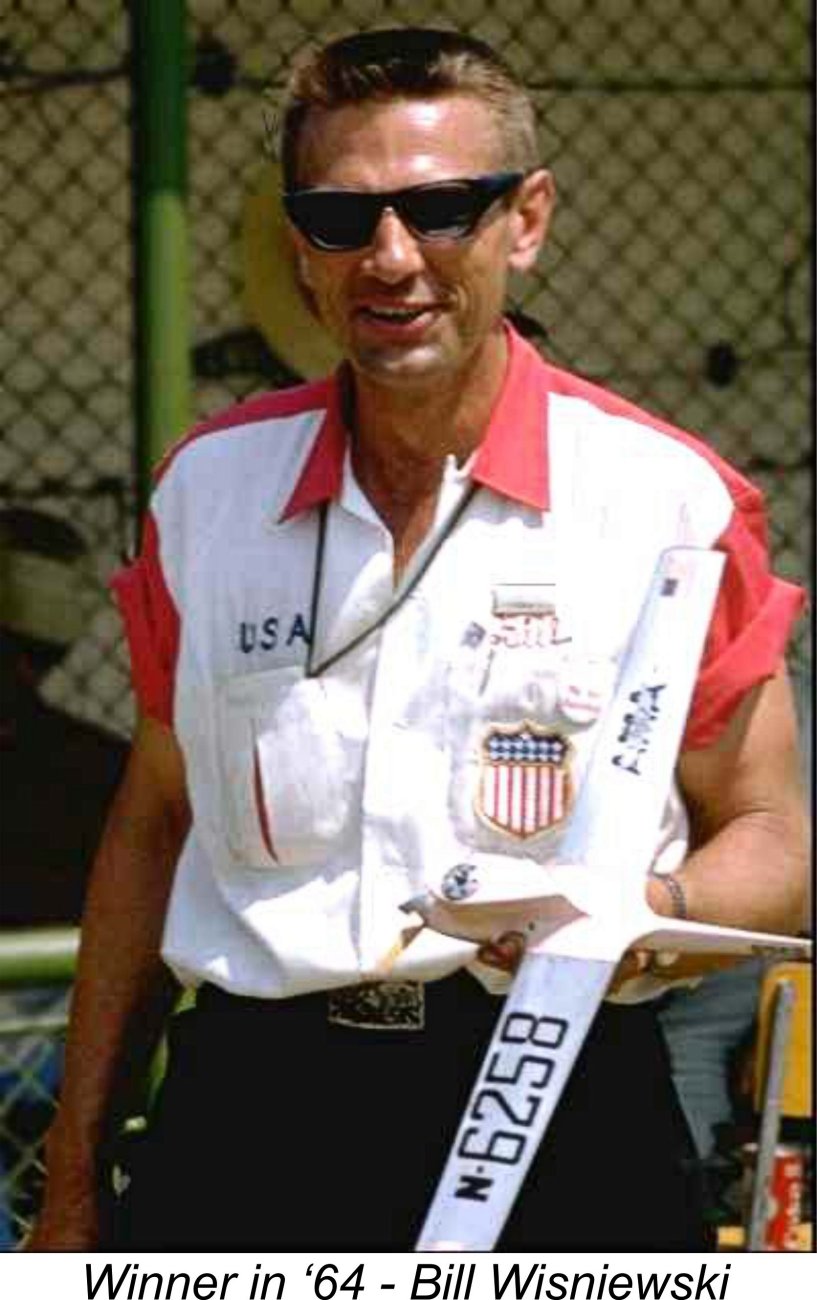 Bill Wisniewski of the USA had won the 1964 world control line speed championship using his then-revolutionary but un-piped Schnürle-ported "Wart" engine. The development of that unit had been forced upon him by Super Tigre maestro Jaures Garofali's
Bill Wisniewski of the USA had won the 1964 world control line speed championship using his then-revolutionary but un-piped Schnürle-ported "Wart" engine. The development of that unit had been forced upon him by Super Tigre maestro Jaures Garofali's 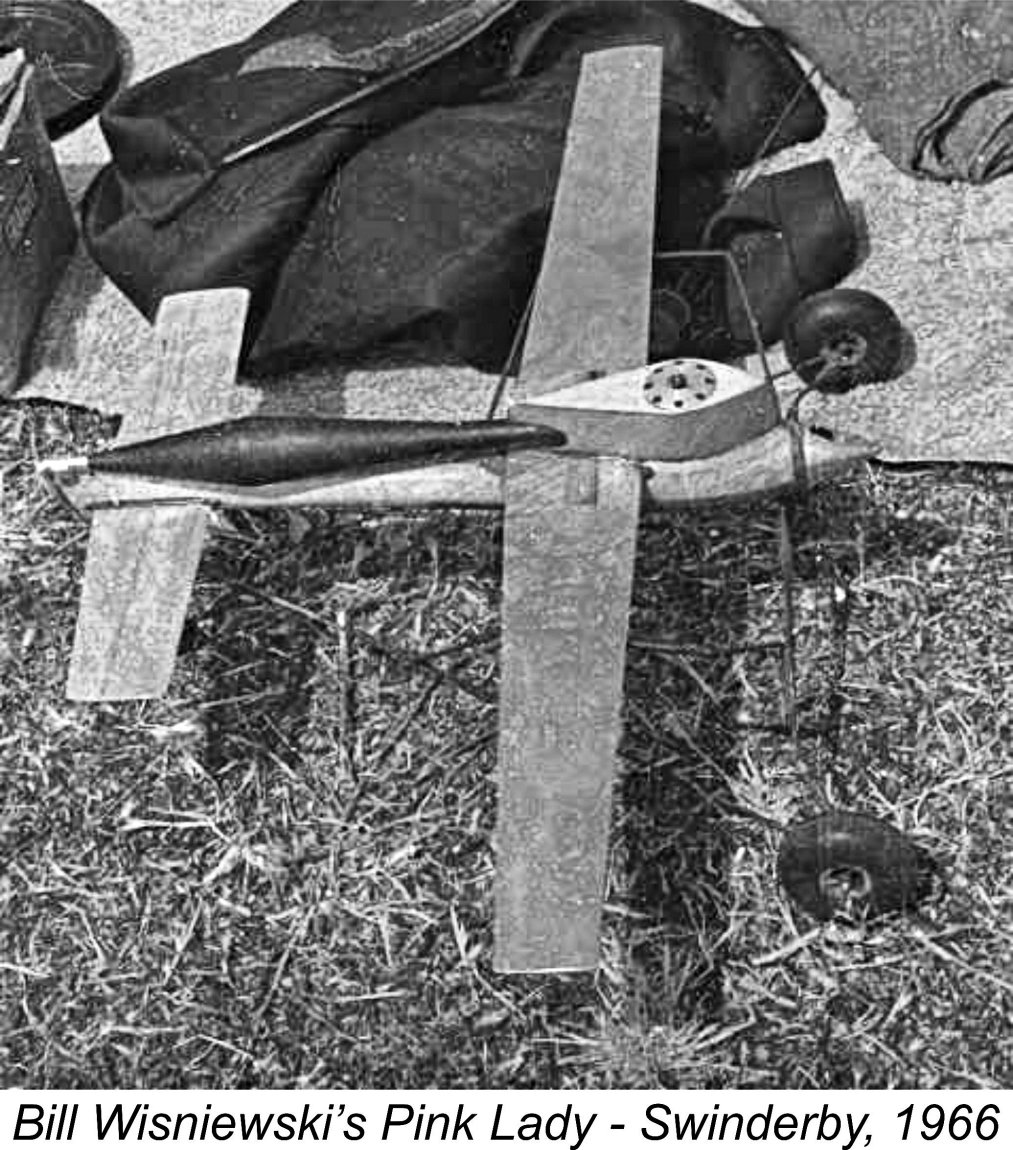 That was it, we all thought? Bloody cocky Americans with all the bull about high speeds! Is that the best they can do? Ho, ho, ho, what a pack of plonkers!
That was it, we all thought? Bloody cocky Americans with all the bull about high speeds! Is that the best they can do? Ho, ho, ho, what a pack of plonkers!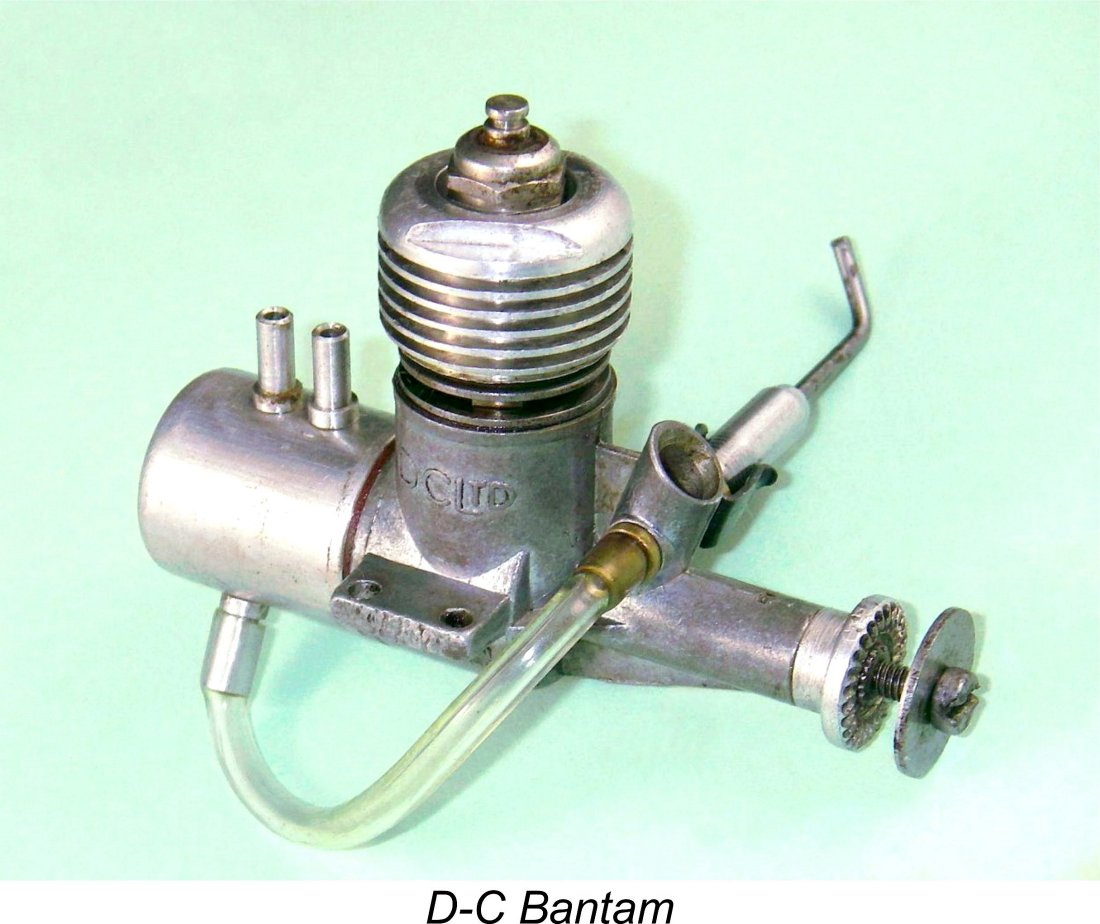 The article on this website about the
The article on this website about the  Even so, I bought the engine. After taking it home, I just about wore it out in the “lump of plywood” test stand that I created for it. As the article says, it was just so easy to start! Not having anything to compare it to, I thought it to be OK – I was happy!
Even so, I bought the engine. After taking it home, I just about wore it out in the “lump of plywood” test stand that I created for it. As the article says, it was just so easy to start! Not having anything to compare it to, I thought it to be OK – I was happy!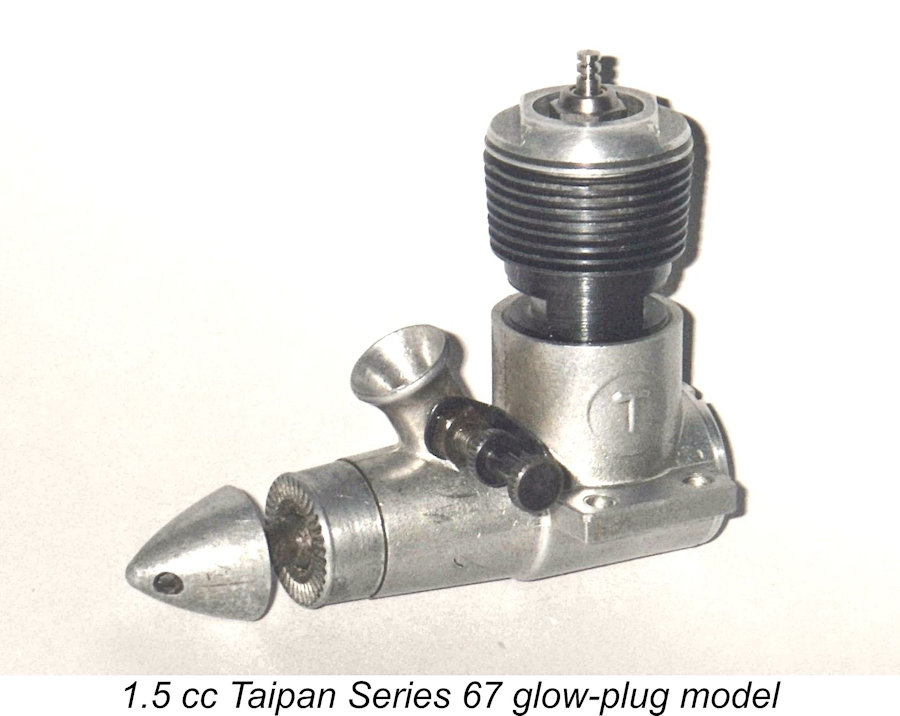 Many years ago, a mate in South Australia (SA) sent me a battered and gummed-up Taipan Series 67 1.5 cc glo. It had been given to him by one of his mates in my home State of Victoria. Since it was made in South Australia, by the time I received the engine it had travelled from SA to Victoria, then back to SA and then back to Victoria (3 trips between the States).
Many years ago, a mate in South Australia (SA) sent me a battered and gummed-up Taipan Series 67 1.5 cc glo. It had been given to him by one of his mates in my home State of Victoria. Since it was made in South Australia, by the time I received the engine it had travelled from SA to Victoria, then back to SA and then back to Victoria (3 trips between the States). 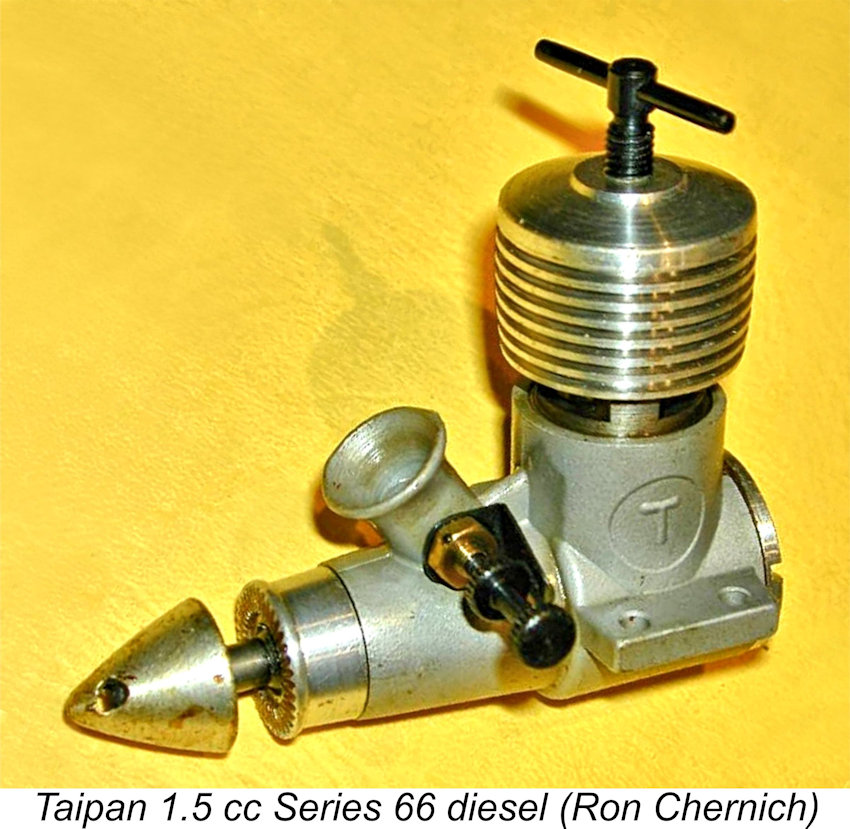 As it happened, I had a broken Taipan Series 66 1.5 cc diesel. Nominal bore of this engine is the same as that of the glow, so I made a conrod (hand filed and drilled with a simple drill press) to allow the use of the piston out of the diesel in the glo. All very heavy compared to the glo components, but if it worked it would be better than nothing! However, a quick test revealed that the replacement piston was also too loose once the old castor buildup washed away.
As it happened, I had a broken Taipan Series 66 1.5 cc diesel. Nominal bore of this engine is the same as that of the glow, so I made a conrod (hand filed and drilled with a simple drill press) to allow the use of the piston out of the diesel in the glo. All very heavy compared to the glo components, but if it worked it would be better than nothing! However, a quick test revealed that the replacement piston was also too loose once the old castor buildup washed away. 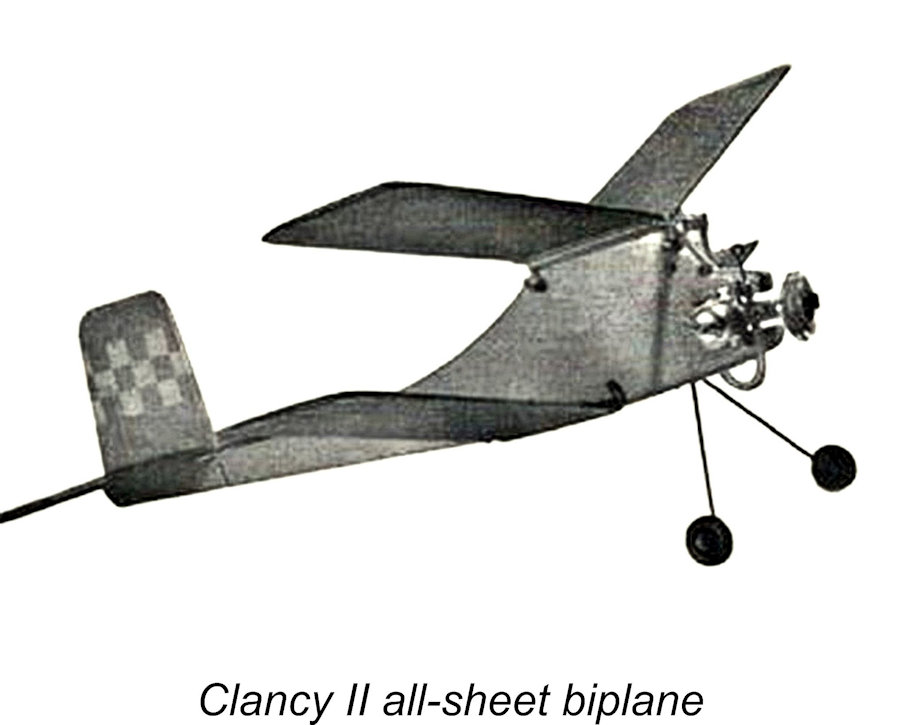 Back to the test stand, and now at least I had an engine that would start predictably if side-mounted with a very high oil-content fuel and heavy priming. However, vibration levels were high thanks to the heavy piston, prompting me to go to a large prop (9x4) and an inlet restrictor to slow things down and keep the vibration manageable. The prop had to be hit rather than flicked (downward whack with the prop at the 10 to 4 position). One-flick (hit) starts when hot were the norm.
Back to the test stand, and now at least I had an engine that would start predictably if side-mounted with a very high oil-content fuel and heavy priming. However, vibration levels were high thanks to the heavy piston, prompting me to go to a large prop (9x4) and an inlet restrictor to slow things down and keep the vibration manageable. The prop had to be hit rather than flicked (downward whack with the prop at the 10 to 4 position). One-flick (hit) starts when hot were the norm. 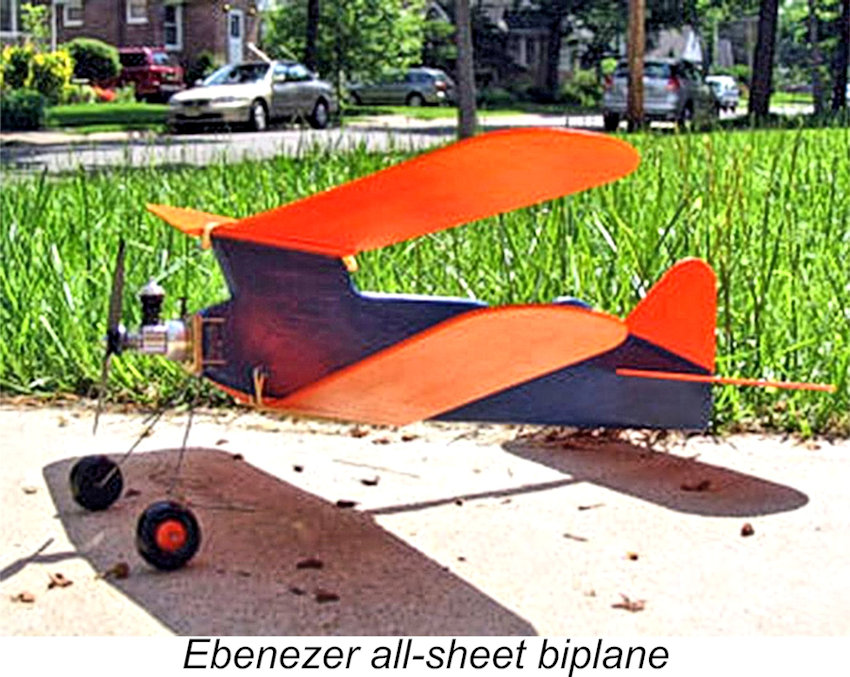 I then built an enlarged 30 in. span “Ebenezer” biplane for the engine (also way over-powered). This made many successful flights until one day it experienced a thermal-assisted flight that ended up in the middle of a copse of gum trees. After hours of searching, I found it stuck very high up and unrecoverable – up a gum tree in the literal sense! There was a guy nearby chopping fallen trees for firewood, so I asked him if he had any ideas. He advised me to just wait - eventually the model would blow down.
I then built an enlarged 30 in. span “Ebenezer” biplane for the engine (also way over-powered). This made many successful flights until one day it experienced a thermal-assisted flight that ended up in the middle of a copse of gum trees. After hours of searching, I found it stuck very high up and unrecoverable – up a gum tree in the literal sense! There was a guy nearby chopping fallen trees for firewood, so I asked him if he had any ideas. He advised me to just wait - eventually the model would blow down. 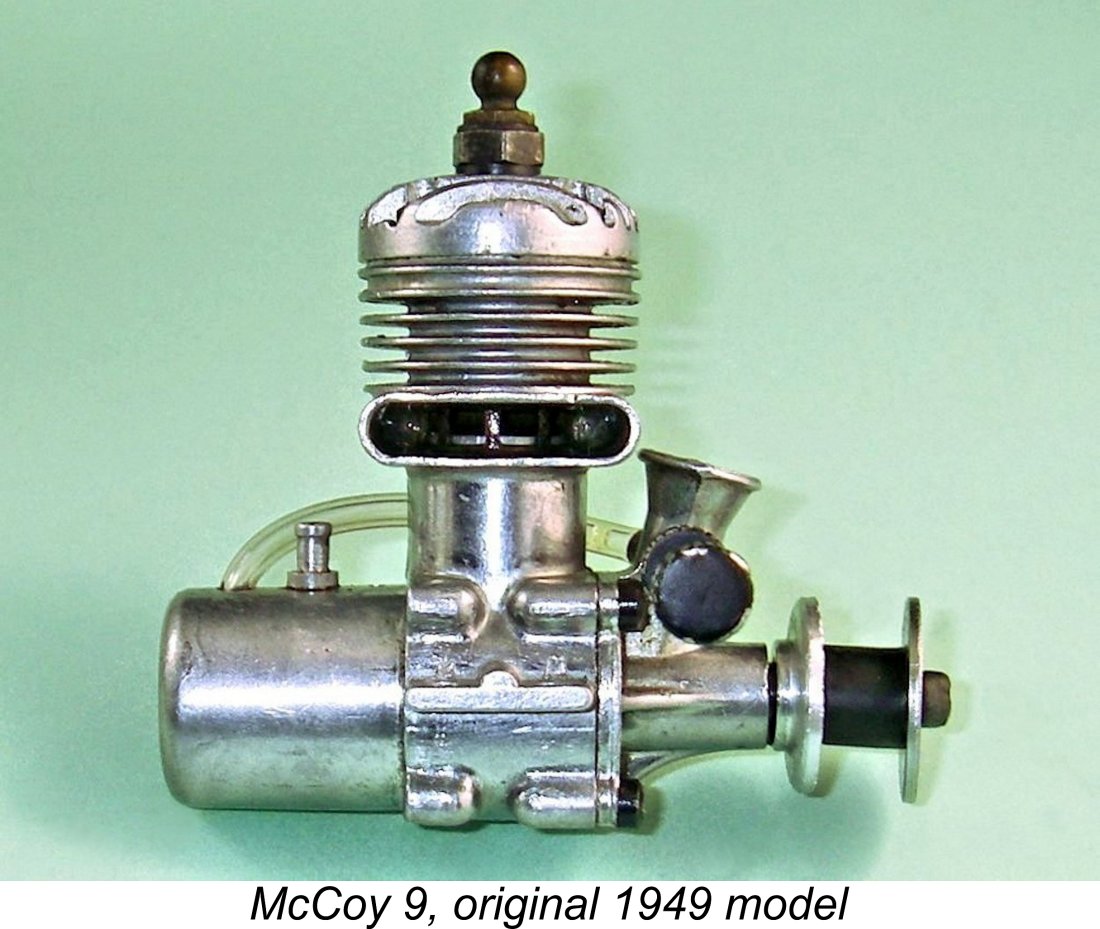 During a look through the various articles on Adrian’s website, I came across the piece on the McCoy .098 glow-plug motor. I enjoyed that article very much! The McCoy .098 was an early favorite of mine because it had good power and puppy-dog handling. Tim Dannels also recalled flying a McCoy .098-powered C/L model on long lines.
During a look through the various articles on Adrian’s website, I came across the piece on the McCoy .098 glow-plug motor. I enjoyed that article very much! The McCoy .098 was an early favorite of mine because it had good power and puppy-dog handling. Tim Dannels also recalled flying a McCoy .098-powered C/L model on long lines. 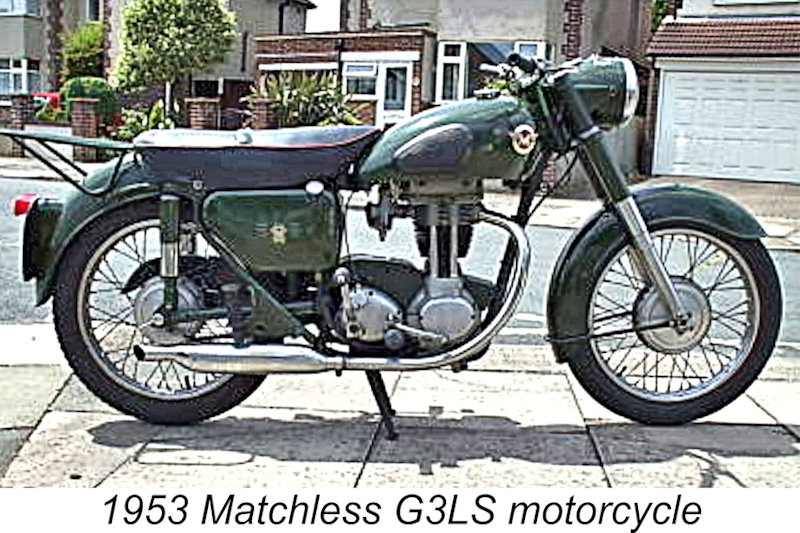 One day I was flying my .19 and .29 control-line stunt models at the local school football field when this fellow showed up on a beautiful Matchless motorcycle – a relatively uncommon import from England. He sat there for a while watching me fly and we got talking between flights. His name was Dave, and he told me that he too was a model airplane guy. I happened to mention how much I liked flying .09 engines in ½A models because the .09’s produced more power and were easier to handle. He then asked me if I was going to be there for a while. I said "Yes, 'til I run out of fuel or it gets too dark." He then climbed back on his Matchless and left.
One day I was flying my .19 and .29 control-line stunt models at the local school football field when this fellow showed up on a beautiful Matchless motorcycle – a relatively uncommon import from England. He sat there for a while watching me fly and we got talking between flights. His name was Dave, and he told me that he too was a model airplane guy. I happened to mention how much I liked flying .09 engines in ½A models because the .09’s produced more power and were easier to handle. He then asked me if I was going to be there for a while. I said "Yes, 'til I run out of fuel or it gets too dark." He then climbed back on his Matchless and left.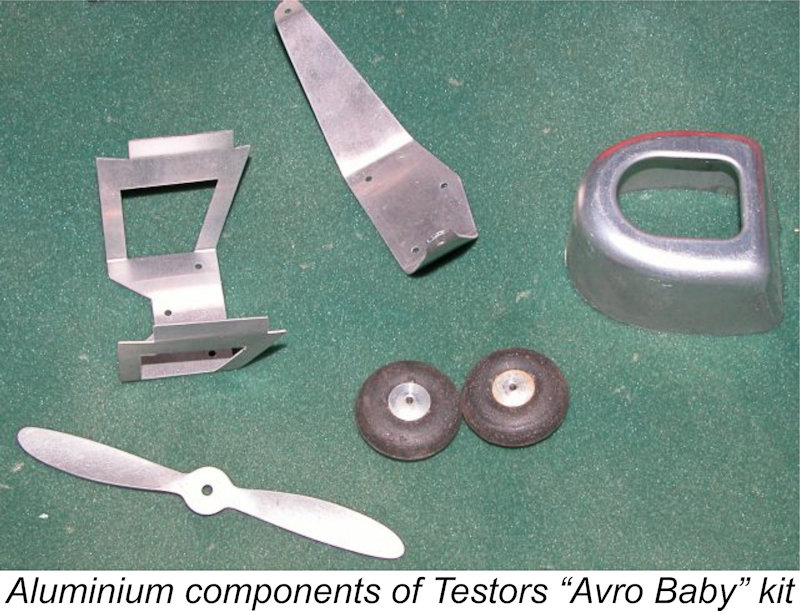 its return. I asked if he wasn't concerned that I might crash it. He said that he had already seen me fly and if it did crash, just save him the engine. With that said, he took off and left me to it.
its return. I asked if he wasn't concerned that I might crash it. He said that he had already seen me fly and if it did crash, just save him the engine. With that said, he took off and left me to it. 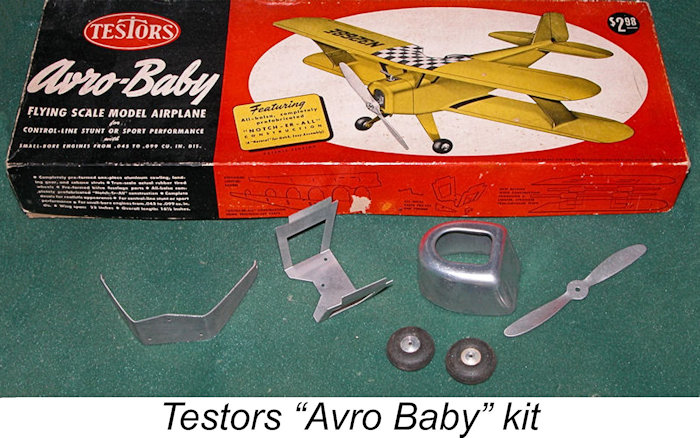
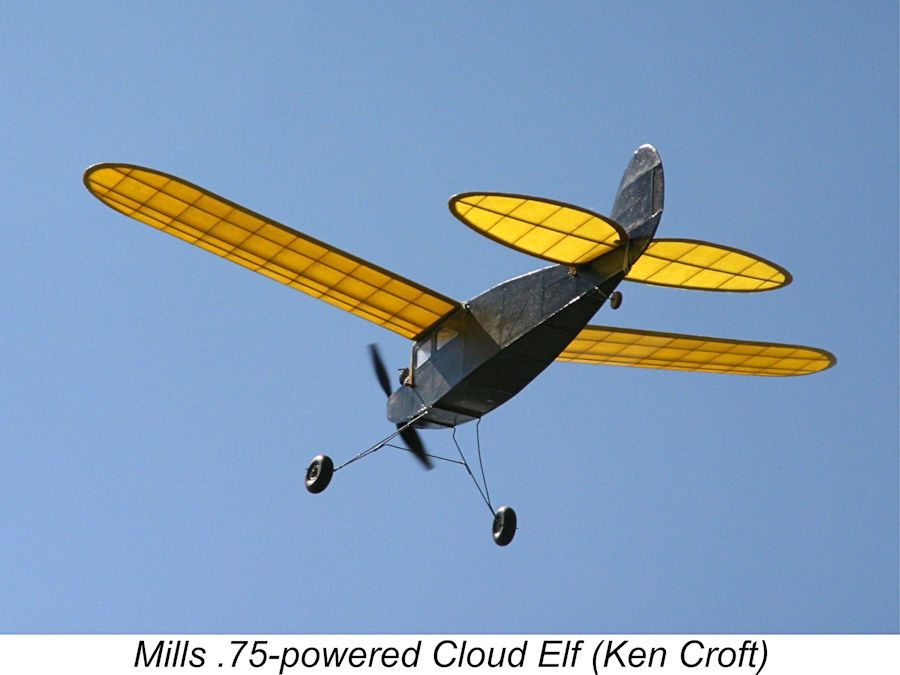 In the realm of the skies, where dreams take flight,
In the realm of the skies, where dreams take flight,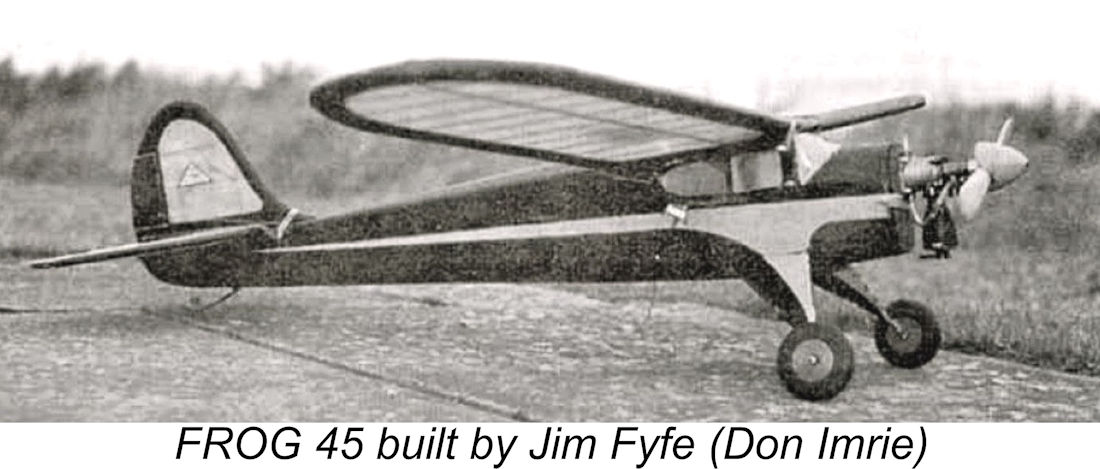 I was in P&L Models in Bellshill, Lanarkshire (Scotland) chatting to proprietors Peter and Lyn McKenna about the latest developments in model equipment, like gas turbine engines, computer radios, etc., etc., when Peter suddenly dropped a bombshell on me. A friend of Lyn’s, who had recently lost her husband, had a very old model built by her late husband many years previously, and would love to see it fly. It had FROG Something written on it and had never been flown.
I was in P&L Models in Bellshill, Lanarkshire (Scotland) chatting to proprietors Peter and Lyn McKenna about the latest developments in model equipment, like gas turbine engines, computer radios, etc., etc., when Peter suddenly dropped a bombshell on me. A friend of Lyn’s, who had recently lost her husband, had a very old model built by her late husband many years previously, and would love to see it fly. It had FROG Something written on it and had never been flown.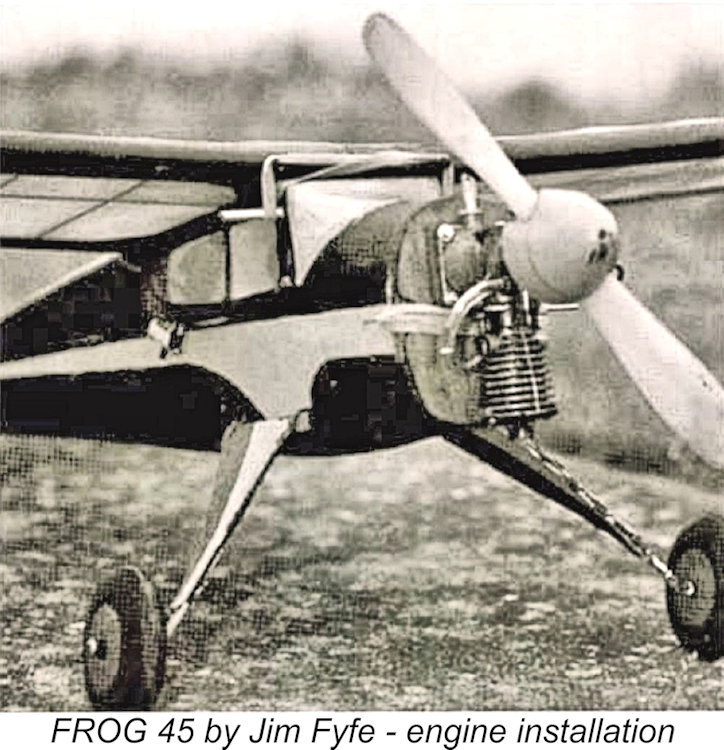 My determination thus fortified, I began by removing all the little brass electrical connectors, which were all held in place by tiny brass bolts. The engine was mounted on a separate plywood bulkhead retained in place by rubber bands, and the brass plate connectors were intended to provide secure electrical continuity to the ignition system. I also removed the pneumatic timer required for operation of this model in free flight form. This timer incorporated a kind of spring-loaded piston which was pulled out prior to launching the model, drawing air into the timer’s cylinder. The piston descended slowly under spring pressure as air leaked out of the cylinder through a tiny hole. When it reached the other end of the cylinder, it broke the ignition circuit. The further you pulled the piston out prior to launch, the longer the engine run. Simple, but very effective, like so many aspects of old-time modelling!
My determination thus fortified, I began by removing all the little brass electrical connectors, which were all held in place by tiny brass bolts. The engine was mounted on a separate plywood bulkhead retained in place by rubber bands, and the brass plate connectors were intended to provide secure electrical continuity to the ignition system. I also removed the pneumatic timer required for operation of this model in free flight form. This timer incorporated a kind of spring-loaded piston which was pulled out prior to launching the model, drawing air into the timer’s cylinder. The piston descended slowly under spring pressure as air leaked out of the cylinder through a tiny hole. When it reached the other end of the cylinder, it broke the ignition circuit. The further you pulled the piston out prior to launch, the longer the engine run. Simple, but very effective, like so many aspects of old-time modelling! 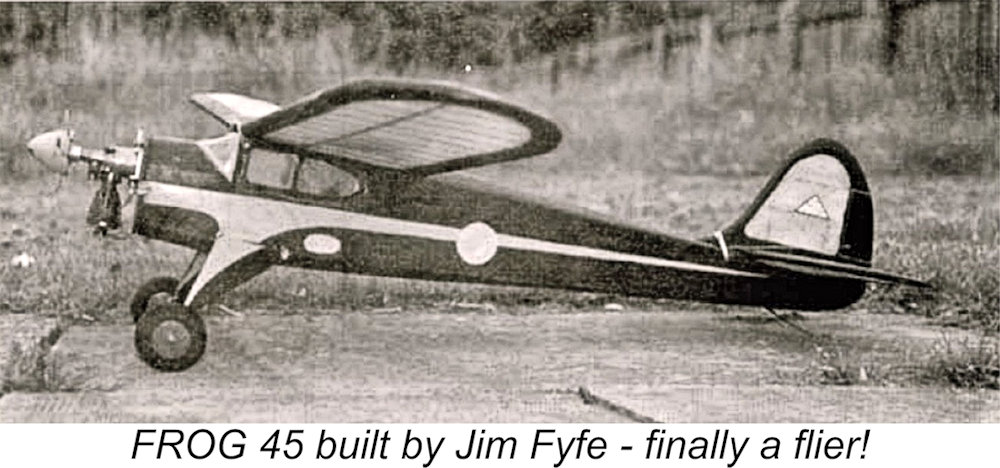 The second flight was somewhat longer, as I had completely filled the tank. However, this flight was a lot more exciting, since the radio suddenly went deaf and stopped listening to instructions! In the ensuing uncontrolled encounter with the ground, the rubber band-retained motor mount did its job, as did the wing retaining band. Both of them released on impact, along with one of the plug-in undercarriage units. The result – no damage whatsoever to the model! A tribute to both the designer and builder of the FROG 45!
The second flight was somewhat longer, as I had completely filled the tank. However, this flight was a lot more exciting, since the radio suddenly went deaf and stopped listening to instructions! In the ensuing uncontrolled encounter with the ground, the rubber band-retained motor mount did its job, as did the wing retaining band. Both of them released on impact, along with one of the plug-in undercarriage units. The result – no damage whatsoever to the model! A tribute to both the designer and builder of the FROG 45!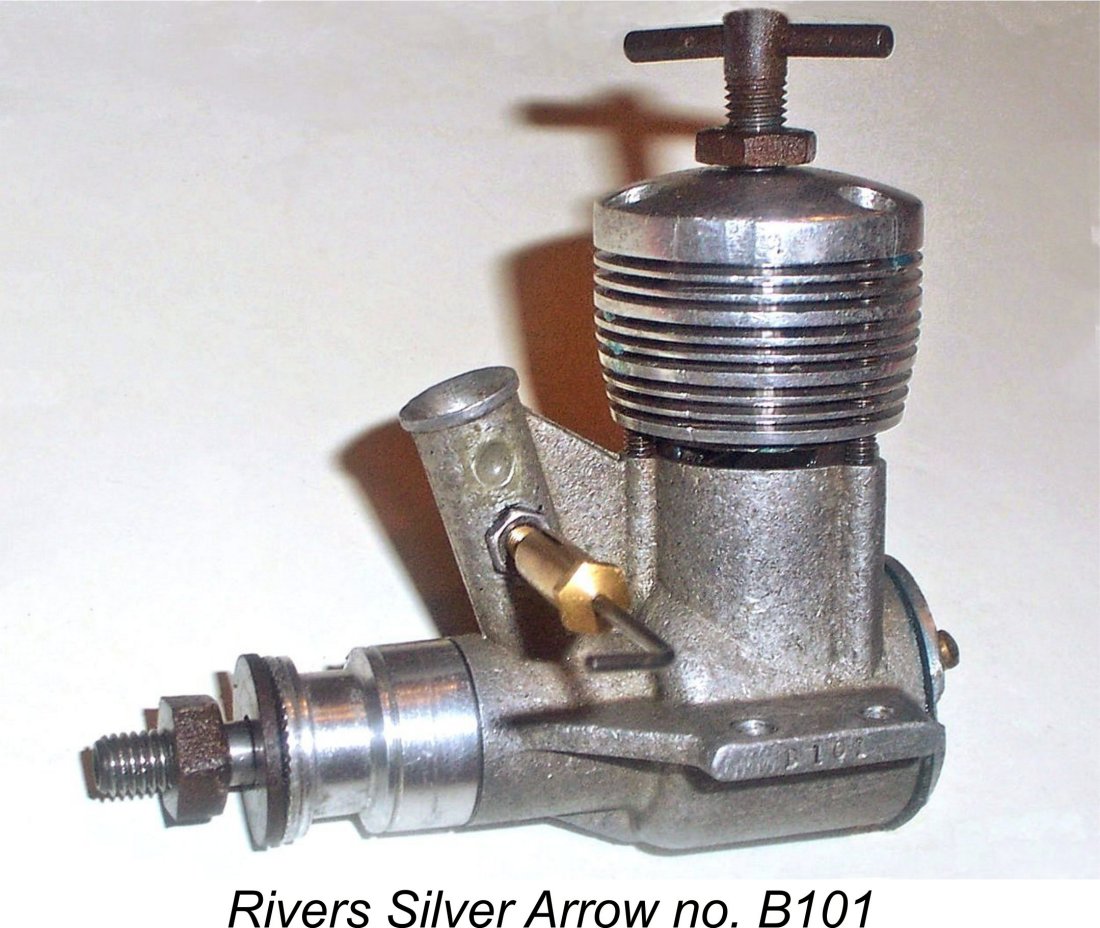 Only yesterday I was going through my garage clearing stuff for a trip to our recycling depot at Chichester, as I prepared to move house. While doing so, I came across my Rivers Silver Arrow engine, which had been stored unused since 1960 after suffering a broken crankshaft in mid-loop, causing my supposedly aerobatic control line kit model to crash! That engine didn’t like me! I pulled it out of the wreckage and sent it to the address on the box, getting it back a few days later repaired without an invoice for the work! (Editor’s note – the early
Only yesterday I was going through my garage clearing stuff for a trip to our recycling depot at Chichester, as I prepared to move house. While doing so, I came across my Rivers Silver Arrow engine, which had been stored unused since 1960 after suffering a broken crankshaft in mid-loop, causing my supposedly aerobatic control line kit model to crash! That engine didn’t like me! I pulled it out of the wreckage and sent it to the address on the box, getting it back a few days later repaired without an invoice for the work! (Editor’s note – the early 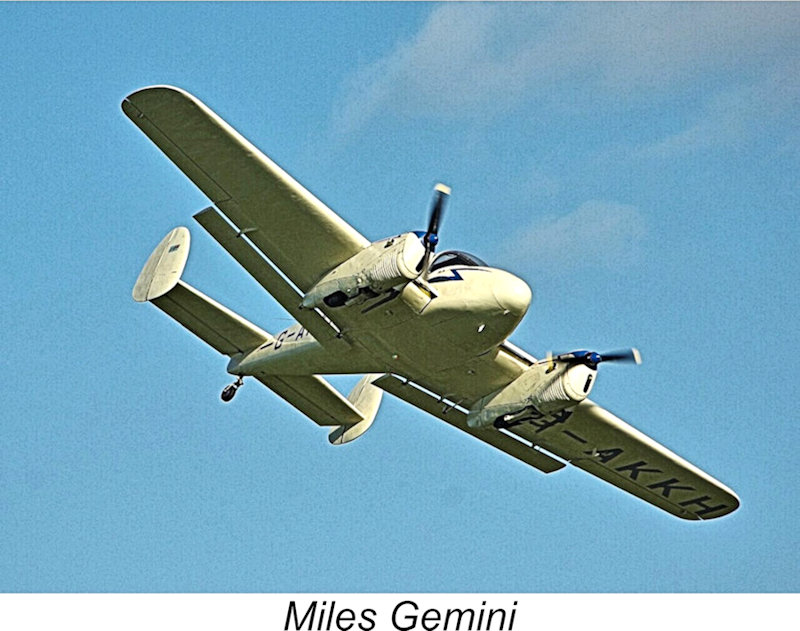
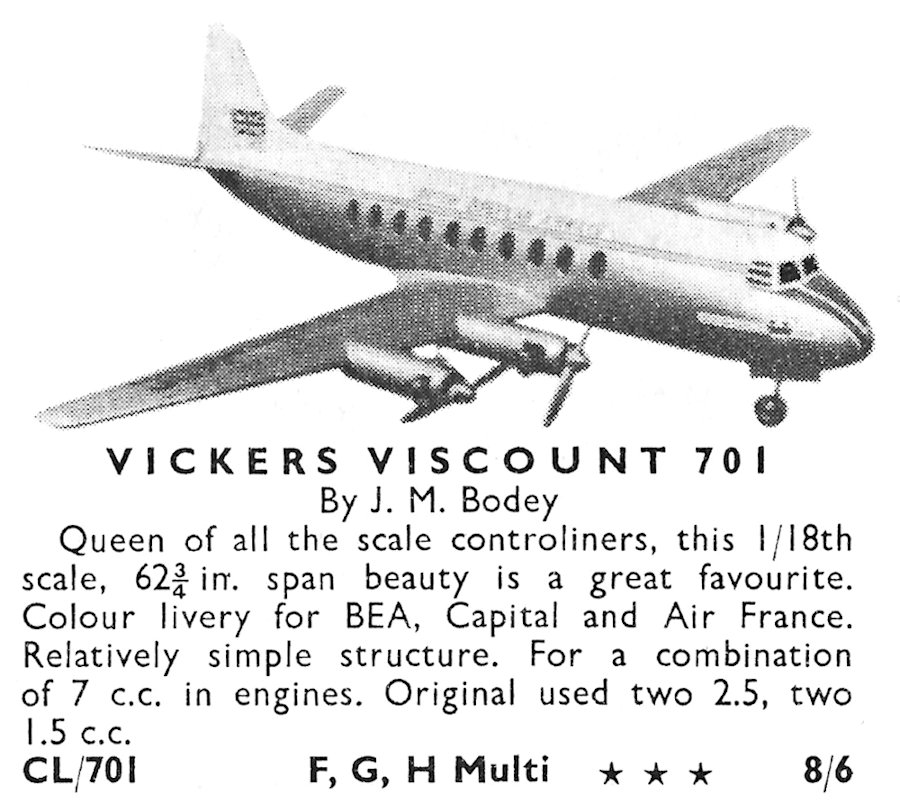 Nothing daunted, the following year we acquired plans (APS no. CL/701) for a four-engined scale model
Nothing daunted, the following year we acquired plans (APS no. CL/701) for a four-engined scale model 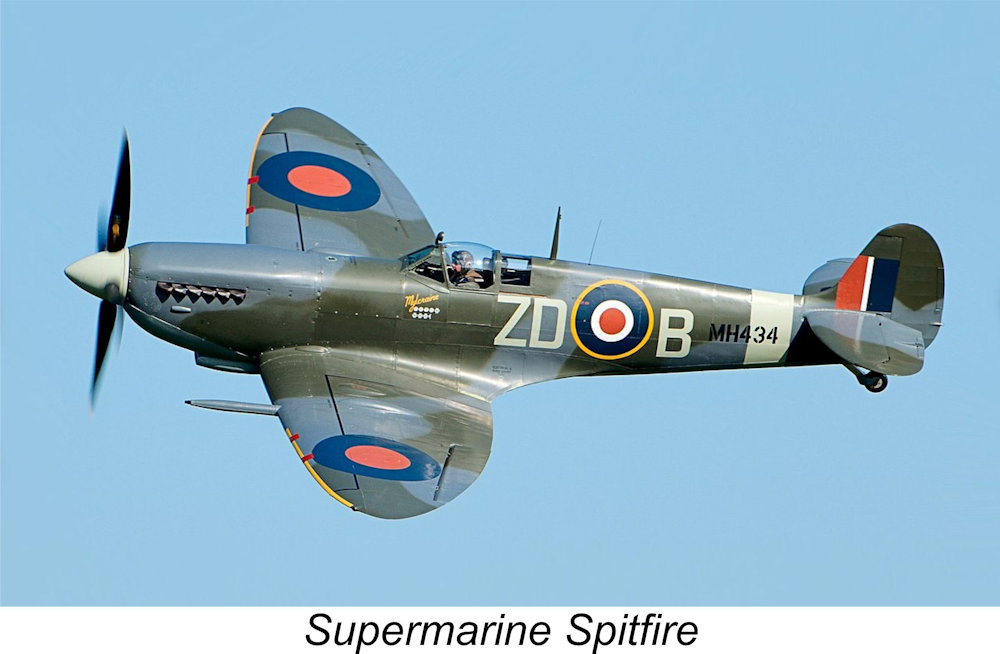
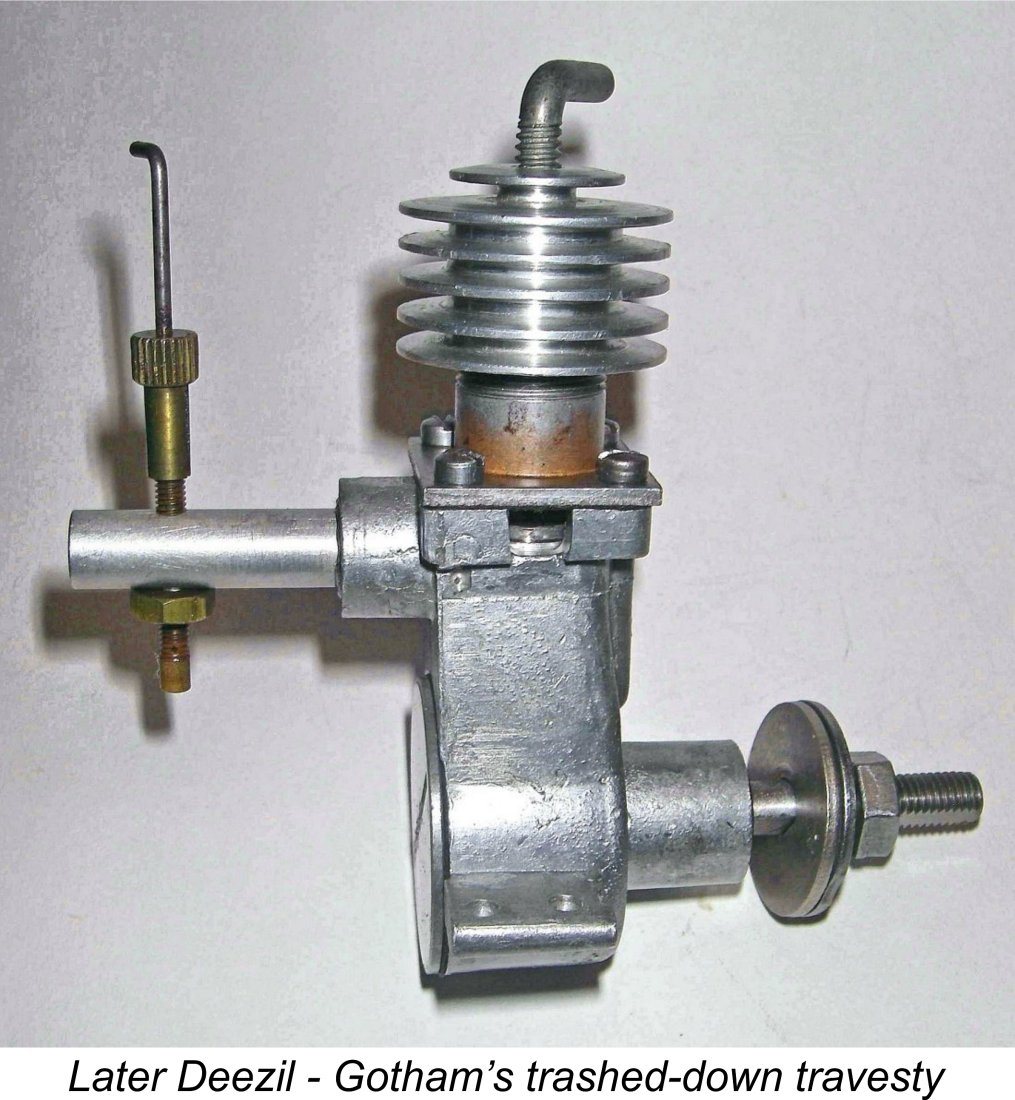 I loved your article about the infamous Deezil! I was one of the many suckers who purchased one, my only excuse being that I was an innocent kid at the time! I was born in February 1937, and the example that I bought was the $2.95 kit engine, so according to your history I would have been about 12 or 13 years old. My Deezil was so poor that the crankcase had imperfections from casting holes in it that I filled with Plastic Wood.
I loved your article about the infamous Deezil! I was one of the many suckers who purchased one, my only excuse being that I was an innocent kid at the time! I was born in February 1937, and the example that I bought was the $2.95 kit engine, so according to your history I would have been about 12 or 13 years old. My Deezil was so poor that the crankcase had imperfections from casting holes in it that I filled with Plastic Wood.